
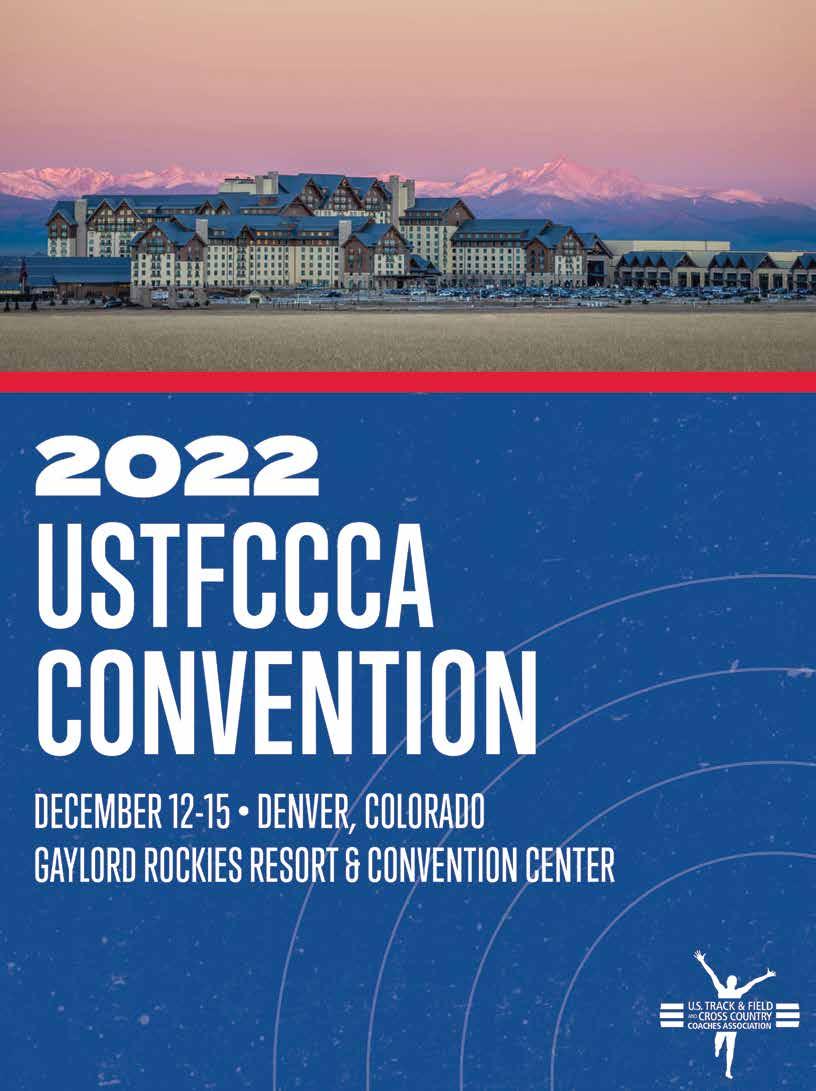
Choosing the “Right” Leg Determining the most effective leg for long jump takeoff BY DR. CHRISTINE BROOKS

The Mozart of Hammer Throwing Understanding the success of Yuri Georgievich Sedykh
DR. VLADIMIR STRELNITSKI
Training Top Level Hurdlers
analysis of leading success factors for 400-meter hurdlers

 MIKE
DR. JASON KARP
MIKE
DR. JASON KARP
DIGGS
FLORIDA WON
HAYWARD
NOVEMBER 2022 techniques 1 IN EVERY ISSUE 4 USTFCCCA Presidents AWARDS 44 USTFCCCA Coaches Hall of Fame Class of 2022 46 The Bowerman Finalists 2022 FEATURES 6 Running Periodization Training theories to run faster BY
Contents Volume 16 Number 2 / November 2022 ON THE COVER: TALITHA
OF
THE WOMEN’S 400 METERS AT THE 2022 NCAA TRACK AND FIELD CHAMPIONSHIPS AT
FIELD. PHOTOGRAPH BY KIRBY LEE IMAGE OF SPORT 28 14 6 14
28
BY
36
An
BY
THORSON


DIVISION PRESIDENTS
LEROY BURRELL
USTFCCCA President
Leroy Burrell is the Head Men’s and Women’s Track & Field Coach at the Auburn University. Leroy can be reached at lrb0054@auburn.edu

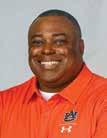
DAVID SHOEHALTER
Track & Field
David Shoehalter is the Direc tor of Track & Field and Cross Country at Yale University. David can be reached at david. shoehalter@yale.edu

DANA SCHWARTING Track & Field
Dana Schwarting is the Head Men’s and Women’s Track & Field Coach at Lewis College. Dana can be reached at schwarda@ lewisu.edu
KENNETH COX Track & Field
Kenneth Cox is the Head Cross Country and Track & Field Coach at Birmingham-South ern College. Kenneth can be reached at kcox@bsc.edu
MIKE COLLINS
Track & Field
Mike Collins is the Head Men’s and Women’s Cross Country and Track & Field Coach at LewisClark State College. Mike can be reached at mcollins@lcsc.edu
KEVIN SULLIVAN
Cross Country
Kevin Sullivan is the Director of Track and Field and Cross Coun try at the University of Michigan. Kevin can be reached at krsully@ umich.edu

PUBLISHER
Sam Seemes
MEMBERSHIP SERVICES
Mary McInnis, Kelsey Nemeth, Kristina Taylor, Dave Svoboda, Adrian Wilson
COMMUNICATIONS
Lauren Ellsworth, Tom Lewis, Tyler Mayforth, Howard Willman
PHOTOGRAPHER
Kirby Lee
EDITORIAL BOARD
Tommy Badon, Scott Christensen, Todd Lane, Derek Yush
ART DIRECTOR
Tiffani Reding Amedeo
TORREY OLSON Cross Country
Torrey Olson is the Head Track & Field Coach at California State University-San Marcos. Torrey can be reached at tolson@csusm.edu


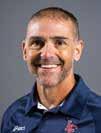
PUBLISHED BY Renaissance Publishing LLC
110 Veterans Memorial Blvd., Suite 123, Metairie, LA 70005 (504) 828-1380
myneworleans.com
DEE BROWN Track & Field
Dee Brown is the Director of Track and Field and Cross Country at Iowa Central CC. Dee can be reached at brown_dee@iowacentral.edu
MATTHEW BARREAU Cross Country
Matthew Barreau is the Head Men’s and Women’s Cross Country Coach at Lewis and Clark College. Matthew can be reached at barreau@lclark.edu

USTFCCCA
National Office
1100 Poydras Street, Suite 1750 New Orleans, LA 70163 Phone: 504-599-8900 Website: ustfccca.org
RYAN SOMMERS Cross Country
Ryan Sommers is the Head Men’s and Women’s Cross Country Coach at Bethel (Ind.). Ryan can be reached at ryan.sommers@bethelcol lege.edu
DON COX Cross Country
Don Cox is the Head Cross Country and Track & Field Coach at Cuyahoga CC. Don can be reached at donald. cox@tri-c.edu

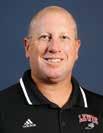

If you would like to submit content for, or advertise your business in Techniques, please contact 504-599-8906 or techniques@ustfccca.org.
Techniques (ISSN 1939-3849) is published quar terly in February, May, August and November by the U.S. Track & Field and Cross Country Coaches Association. Copyright 2022. All rights reserved. No part of this publication may be reproduced in any manner, in whole or in part, without the permission of the publisher. techniques is not responsible for unsolicited manuscripts, photos and artwork even if accom panied by a self-addressed stamped envelope. The opinions expressed in techniques are those of the authors and do not necessarily reflect the view of the magazines’ managers or owners.
Periodical Postage Paid at New Orleans La and Additional Entry Offices. POSTMASTER: Send address changes to: USTFCCCA, PO Box 55969, Metairie, LA 70055-5969.
4 techniques NOVEMBER 2022
NCAA DIVISION I USTFCCCA PRESIDENT NCAA DIVISION II NCAA DIVISION III NAIA NJCAA

 KIRBY LEE IMAGE OF SPORT
KIRBY LEE IMAGE OF SPORT
Running Periodization
Training Theories to Run Faster
“ ”
In the modern era, most of our under standing of periodization comes from the scientists, training theorists and coaches of the former Soviet Union, with many of the original modern texts on periodization published in Russian. The scientific rationale for periodization is rooted in Dr. Hans Selye’s General Adaptation Syndrome of 1950, and is based on the premise that athletes need to receive an optimal training stimulus that is balanced with appropriate recovery to cause adaptation and favorable long-term training effects. Periodization is thus a blueprint of predetermined sequential periods of focused training that guides the coach and runner in the acquisition of specific characteristics of fitness. It is not a static blueprint, but rather a dynamic one that the coach and runner use to formulate an optimal training program.
While variation is an important factor, periodization is more than simple variation of training stimuli; it’s about how and when training stimuli are varied and how and when the volume and intensity of training are manipulated throughout the year, always con sidering the runner’s progress and modifying the training accordingly.
PERIODIZATION ASSUMPTIONS
Although periodization is a valuable blueprint to build athletes’ training, the theoretical and historical frameworks of periodization are not always in line with biological truths, and we are therefore left with several assumptions.
For starters, periodization assumes that there are established time frames for the development and retention of specific fitness adaptations and that biological adaptation to a given training plan follows a predictable course. However, as any coach who has been coaching for a while knows, not every runner
adapts or progresses at the same rate or to the same extent. Indeed, individual runners often respond differently from one another, even with identical workouts and training pro grams. Research has also shown a lot of vari ability in the response to both cardiovascular and strength training.
That leads us to the second assumption, that training plans, training phase duration and rates of progression can be generalized among the population, or that the training of elite runners, who are, by definition, extreme outliers, can be generalized and extrapolated to other elite runners or to less talented runners. Although the training of elite runners is often celebrated and admired, we actually don’t learn much from studying how elite athletes train, because their results are more a product of their extreme talent (both their latent talent and their talented responsiveness to training) than of their specific training.
A third assumption of periodization is that various fitness attributes are best developed in a sequential way (e.g., strength before power or endurance before speed). And fourth is the assumption that training can be adequately forecast: that we can predict what’s going to happen later so that we can plan for it now.
One of the reasons these assumptions exist is that periodization is a difficult thing to study scientifically, mostly because it’s difficult to use the scientific method to test whether or not one method of training is better than another method of training. Scientists like to (and need to) control (independent) variables to isolate the (dependent) variable that they’re trying to study. Variables that get in the way are called confounding variables for a reason—they con found the results.
If two people (or 20 people in each of two groups) train differently—person A (or group
A) trains in a periodized way and person B (or group B) trains in a nonperiodized way, or they train in different periodized ways—and, six months later, person A (or group A) runs one mile or 5K faster than person B (or group B), can we say that the better race performance was because of the periodized training? Can we conclude that periodized training is better than nonperiodized training? What if we tried a repeated measures study design, in which a periodized training plan and a nonperiodized training plan (or two different kinds of peri odized plans) are both given to one group of 20 runners in random order, with ten runners given plan A first and ten others given plan B first (which, statistically speaking, is a more powerful study design than an independent groups design). Can we then determine which training plan is better? How do we account for the cumulative effect of training and the effect of initial training on later training and on race results? How do we know that a runner’s race performance is the result of his or her training in the six months leading up to that race, rather than the result of the previous six months of training? These are difficult questions for sci ence to definitively answer.
Before we discuss the different periodization models, it’s helpful to review how the pieces of training are put together in a periodized plan.
MACROCYCLES
Periodization divides a year of training into major periods called macrocycles, which are about three to four months and most often comprise a single competitive season (e.g., a cross-country season or track and field season for a high school or college runner). In endur ance sports like distance running, macrocycles are typically pieced together to create an annual cycle (which can be shorter than one
NOVEMBER 2022 techniques 7
YOU CAN’T UNDER STAND THE VALUE OF A WHOLE PROCESS BY SEPARATING THE PARTS FROM THE PRO CESS, OR THE PROCESS FROM THE PARTS.
PART 1: LINEAR PERIODIZATION
PERIODIZATION PHASES FOR ONE TARGET RACE
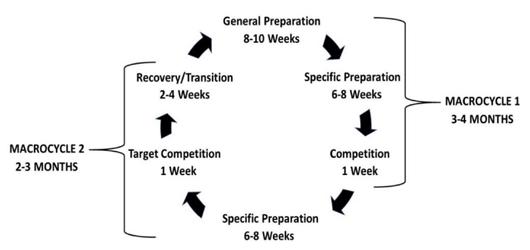
PERIODIZATION PHASES FOR ONE TARGET RACE (2 MACROCYCLES)
year for less experienced/recreational runners), while shorter periods than a year are used for strength/speed/power sports. The training of elite athletes can also be planned with larger cycles, like four-year Olympic cycles, or similar ly for serious high school and college runners, four-year school cycles.
Within each macrocycle is a preparatory phase, which is sometimes further divided into general and specific preparatory phases, a competitive phase that develops the specific competitive sport skills while maintaining the general physical performance achieved from the preparatory phase, and a transition phase of two to four weeks that serves as a recovery between macrocycles. The preparatory phase contains general, high-volume, low-intensity training to develop aerobic, cardiovascular and metabolic characteristics, and structural integrity, and the competitive phase contains specialized, high-intensity, low-volume train ing and races to develop anaerobic character istics and the specific skills needed to race.
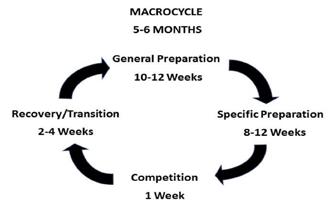

For runners who train for one target race, rather than plan the training for multiple sea sons of racing with multiple races at the end of
each season, it’s better to either lengthen the duration of the three- to four-month macro cycle with longer general and specific prepara tion phases and a short (one week) competi tion phase, or piece two or three macrocycles together with shortened one-week competition phases for benchmark races leading up to the target race and eliminating the recovery/transi tion phase until after the target race.
MESOCYCLES
Macrocycles are divided into medium-size mesocycles, which typically last three to six weeks. Each mesocycle has a theme, with one or two training objectives or targets. The mesocycle is the “scene” of the training pro gram. Like the director of a movie, the coach decides on the theme of the scene to meet the overall fitness objectives. As fitness improves, each successive mesocycle should involve average greater training loads than the cycle just completed.
Regardless of the race distance for which your athletes are training, the initial meso cycles are similar because the purpose is similar—to increase aerobic capacity. The
differences lie in how high the weekly volume gets and how much time you devote to the development of aerobic capacity, with longer races like the half-marathon and marathon requiring higher volume and more time on the aerobic component than shorter races like 800 meters, 1,500 meters/mile, and 5K.
However, these differences are not as major as you might think, since all races that take longer than two minutes are more aerobic than anaerobic—so even training for a onemile race requires a lot of aerobic training. The major differences in the training program come later, as paths diverge through the spe cific preparation and competition phases.
MICROCYCLES
Within each mesocycle are several (3 to 6) smaller periods called microcycles, which are typically one week. It’s likely that seven days is used to align with the weekly calendar because that is the optimal time for adapta tion and the repetition of a specific stressor.
There doesn’t seem to be anything magical or scientific about seven days. Microcycles could last longer, like 10 to 14 days, depending on
8 techniques NOVEMBER 2022 RUNNING PERIODIZATION
their objectives, the runner’s time frame for adaptation and the amount of time needed for recovery between workouts.
The microcycle is the “working unit” of the training program. Every microcycle should have its own specific objectives, which are integrated with the objective of the entire mesocycle. Like the movie director, the coach directs the training and prescribes the specific work based on the theme of the scene.
Think of the training cycles as a house. The macrocycle is the fully-constructed house.
The mesocycles are the rooms of the house. The microcycles are the furniture in each room.
One macrocycle (house) has 2 to 5 meso cycles (rooms) that have 3 to 6 microcycles (furniture) in each.
Now, let’s take a look at the different mod els of periodization. Because there is not just one way to build the house.
LINEAR PERIODIZATION
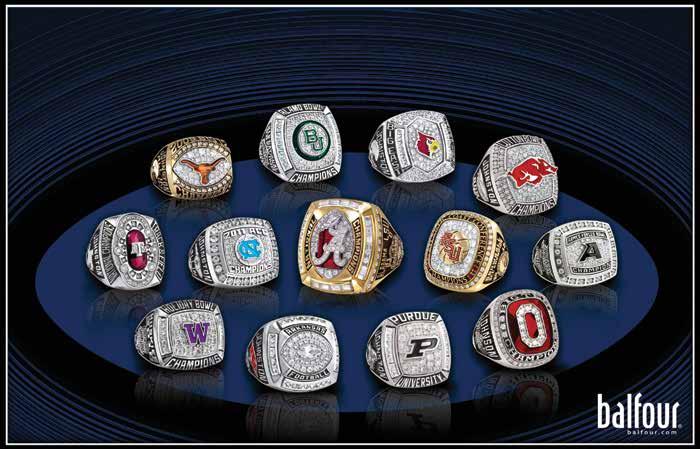
The traditional periodization model of train ing that many elite runners and coaches have adopted and that has trickled down to nonelite runners is rooted in Soviet Union training the ory, which was based on the premise that gen eral (aerobic endurance) training should pre cede specific (anaerobic speed) training, in part because it was believed that a well-developed foundation of endurance, achieved by highvolume/low-intensity training, is crucial to tol
erate and respond optimally to an increase in training intensity. Thus, the traditional model of periodization begins with a steady increase in low-intensity volume and, as training pro gresses throughout a macrocycle, initial meso cycles are of higher volume and lower intensity and later mesocycles are of higher intensity and lower volume. This model of periodization is called linear periodization because there is a decrease in volume and matched increase in intensity over time. In reality, linear periodiza tion should be called curvilinear periodization, since the changes in both volume and intensity are not (and should not be) linear.
Linear periodization is largely theoreti cal and traditional in nature, validated only by athletes’ success. Controlled studies on the physiological and performance results of long-term linear periodization, especially on distance running performance, and studies comparing the effects of linear periodization to other types of periodization, are scarce.
It seems to me that linear periodization, progressing from high volume/low intensity to low volume/high intensity, makes sense for shorter races, from 800 meters to 5K. The end of the macrocycle includes the highest inten sity of training and most closely matches the intensity of the upcoming races, which means that your athletes are doing the most racespecific work as they get closer to the races.
GENERAL PREPARATION PHASE
During the general preparation phase of a lin ear periodization program, the initial emphasis is on general endurance by building up the weekly volume. The intensity of daily runs should be low, about 70 to 80 percent max heart rate (65 to 70 percent VO2max) for 30 minutes to about 90 minutes (longer if training for a half-marathon or marathon). Runs should feel gentle and should build your athletes up rather than tear them down. It’s easy in this phase to run too fast, in part because there are no hard workouts tomorrow for which your athletes need to be ready. But this phase is not about pushing the pace. Runners must be dis ciplined to run easy, and to accumulate more and more easy running over time.
When increasing volume, first increase the duration of each run. Longer single runs build endurance. If your athletes run less than 40 to 50 miles per week, it’s better to run just once per day. If their runs reach an average of exceeding an hour per day, increase their volume by running twice per day a couple of times per week. Double runs enable your ath letes to increase their training load while mini mizing stress. With two runs, they also get two hormonal responses and thus two opportuni ties for adaptation, because they have more frequent signals for protein synthesis.
Among elite endurance athletes (and presumably also for everyone else), a large training volume during the general prepara tion phase appears to be an important charac
NOVEMBER 2022 techniques 9
RUNNING PERIODIZATION
teristic for exceptional athletic performance several months later, although it is not clear why. There is very little documentation regarding the correlation between training in the preparation phase and physi ological capacity or performance in the competition phase months later. Scientific studies always test sub jects immediately prior to, during and immediately after a training intervention, not again months later. As mentioned previously, one of the assumptions of periodization is that it can predict future responses from the training your athletes do now.
SPECIFIC PREPARATION PHASE
The weekly running volume continues to increase through the specific preparation phase of the linear periodization program, as your athletes focus on spe cific quality endurance, with fartleks and threshold runs to raise their acidosis threshold, which train their ability to hold a faster aerobic pace. Easy runs should continue in this phase as you add one to two threshold workouts per week. These workouts can be continu ous threshold runs, interval workouts, or fartleks.
The next part of the specific endurance phase includes aerobic power (VO2max) training, through the use of interval workouts that train the cardiovas cular system’s ability to deliver oxygen to the working muscles. The cardiovascular adaptations associated with interval training, including hypertrophy of the heart’s left ventricle and a greater maximum stroke volume and cardiac output, increase your athletes’ VO2max, raising their aerobic ceiling. Cardiac per formance is a primary determinant of VO2max. In comparison to acidosis threshold training, which is mostly about what’s happening in the runner’s legs, the site of adaptation of VO2max training moves from the skeletal muscles to the cardiovascular sys tem. Thus, the most powerful stimulus for change in cardiac function (VO2max) is different from the most powerful stimulus for change in skeletal muscle aero bic capacity (acidosis threshold). This is one of the reasons why improvement in VO2max takes less time (weeks to months) than improvement in the acidosis threshold (months to years).
For most runners who train for 5K, 10K, half-mara thon, and marathon, threshold training and VO2max training, together with continued high-volume/lowintensity training that improves running economy, are enough for the specific preparation phase, since those races are most influenced by those physiological factors. For runners training for middle-distance races (800 meters to 3,200 meters), some anaerobic capac ity training that targets anaerobic glycolysis (speed endurance) should also be included in this phase.
COMPETITION PHASE
During the competition phase, the training transi tions from aerobic metabolic and cardiovascular work to anaerobic metabolic and muscular work, with anaerobic capacity (speed endurance) and races taking center stage. Weekly volume begins to
decrease as intensity increases.
Of the first three phases, the competition phase is the most varied between runners. For example, a high school track runner may have a series of important short races (from 800 meters to 3,200 meters) in the span of one month, while a marathon runner may have one important long race on one day. The number and duration of these races will dictate exactly what training is done in the competi tion phase. An 800-meter runner and miler will do a considerable amount of anaerobic speedwork, while a marathon runner will spend more time developing him- or herself aerobically and doing more racespecific endurance training.
RECOVERY/TRANSITION PHASE
Runners would love to run at their peak all year round. However, physiological peaks are rather fleet ing and, after they occur, continuing to train with more volume and intensity doesn’t do any good; it’s better to work in peaks and valleys. So it’s important to come off that peak and recover, so your athletes can train to reach a higher peak later in the year. Thus, the final phase of a linear periodization train ing program is recovery/transition, during which your athletes recover from the previous training and racing and get ready, both physically and psycho logically, for the beginning of a new macrocycle. This phase includes a combination of complete rest, cross-training, and perhaps some very easy, short runs. In general, the longer the preceding buildup (macrocycle), the higher the volume, and the lon ger the targeted race just completed, the longer the recovery/transition phase.
PART 2 OF THIS SERIES ON PERIODIZATION WILL DISCUSS REVERSE LINEAR PERIODIZATION.
REFERENCES
Naclerio, F., Moody, J., and Chapman, M. Applied periodization: a methodological approach. Journal of Human Sport & Exercise, 8(2):350-366, 2013.
Bompa, T.O. Periodization: Theory and Methodology of Training. Champaign, IL: Human Kinetics, 1999.
Tønnessen, E., Sylta, Ø., Haugen, T.A., Hem, E., Svendsen, I.S., and Seiler, S. The road to gold: train ing and peaking characteristics in the year prior to a gold medal endurance performance. PLoS ONE, 9(7):e101796, 2014.
The Full Names and Complete Mailing Addresses of the Publisher, Editor and Managing Editor are: Sam Seemes, Kelsey Nemeth, 1100 Poydras St., Suite 1750 New Orleans, LA 70163. Techniques is owned by USTFCCCA, 1100 Poydras St., Suite 1750 New Orleans, LA 70163.
The Average Number of Copies of Each Issue During the Preceding 12 Months: (A)
Total Number of Copies (Net press run): 7.004 (B3) Paid
Distribution Outside the Mails Including Sales Through Dealers and Carriers, Street Vendors, Counter Sales and Other Paid
Distribution Outside USPS: 0 (B1) Paid Circulation through Mailed Subscriptions: 6,901 (C) Total Paid Distribution: 7,004 (D4) Free Distribution
Outside the Mail: 0 (E) Total Free Distribution: 0 (F) Total Distribution: 7,004 (G) Copies not Distributed: 103 (H) Total: 7,004 (I) Percent Paid: 99%
The Number of Copies of a Single Issue Published Nearest to the Filing Date: (A) Total Number of Copies (Net press run): 7,211 (B3) Paid
Distribution Outside the Mails Including Sales Through Dealers and Carriers, Street Vendors, Counter Sales and Other Paid Distribution Outside USPS: 0 (B1) Paid Circulation through Mailed Subscriptions: 7,101 (C) Total Paid Distribution: 7,211 (D4) Free Distribution
Outside the Mail: 0 (E) Total Free Distribution: 0 (F) Total Distribution: 7,101 (G) Copies not Distributed: 110 (H) Total: 7,211 (I) Percent Paid: 99%
Signed, Sam Seems
STATEMENT REQUIRED BY TITLE 39 U.S.C. 3685 SHOWING
OWNERSHIP, MANAGEMENT
DR. JASON KARP IS A COACH, EXERCISE PHYSIOLOGIST, BESTSELLING AUTHOR OF 12 BOOKS AND MORE THAN 400 ARTICLES, AND TED SPEAKER. HE IS THE 2011 IDEA PERSONAL TRAINER OF THE YEAR AND TWO-TIME RECIPIENT OF THE PRESIDENT’S COUNCIL ON SPORTS, FITNESS & NUTRITION COMMUNITY LEADERSHIP AWARD. HIS REVO₂LUTION RUNNING™ CERTIFICATION HAS BEEN OBTAINED BY COACHES AND FITNESS PROFESSIONALS IN 25 COUNTRIES. IN 2021, HE BECAME THE FIRST AMERICAN DISTANCE RUNNING COACH TO LIVE AND COACH IN KENYA. RUNNING PERIODIZATION AND HIS OTHER BOOKS ARE AVAILABLE ON AMAZON.
AND CIRCULATION OF TECHNIQUES, Publication #433, Published Quarterly at 1100 Poydras Street Suite 1750 New Orleans, LA 70163. The business office of the publisher is 1100 Poydras St., Suite 1750 New Orleans, LA 70163.
10 techniques NOVEMBER 2022




14 techniques NOVEMBER 2022
KIRBY LEE IMAGE OF SPORT
Choosing The “Right” Leg
Determining the most effective leg for long jump takeoff
The vertical ground reaction forces generated during the takeoff of a long jump have been measured at more than 10 times body weight (Linthorne et al., 2011). Clearly, jumping for distance demands a strong and powerful leg. Research suggests that for right-handed adults, the bones of the left leg are denser than those of the right leg. This indicates the domi nant function of the left leg is to produce force and stabilize the body against gravity (Cuk et al., 2001). Logic follows, therefore, that righthanded jumpers should takeoff using their left leg and swing with their right leg.
However, video of the 2016 Rio Olympic long jump finals indicated that 5 of the 12 male contestants used a right leg takeoff (~ 40%). Eight of top 12 female contestants (~65%) used a right leg takeoff.
Research confirms that the stronger left leg is not always used to jump. Indeed, people are sometimes unable to recall what leg they use to jump (Melick et al., 2017). While they are able to recall the leg they use to kick a ball, they are less accurate when asked to recall their jumping leg. Around 62% of men in the Melick, et al., (2017) study said they used their right leg to jump (Table 1). However, only 52.4% were observed using their right leg. Women were only a little more accurate. Around 71% of men and 86% of women used the same leg each time they jumped indicating that some of them occasionally, switched legs.
In this article, I provide some basic science behind why selecting the most effective takeoff leg for long jumping is a complex decision that cannot be made with any degree of certainty until after 11 years of age and one year of prac tice jumping from both legs.
THE LONG JUMP TAKEOFF IS THE INTEGRATION OF 7 TASKS
The successful outcome of a long jump takeoff depends on how well seven tasks are inte grated. Four of these tasks occur during the approach (Hay, 1986), and three occur while the foot is on the takeoff board (Muraki et al.,
2008).
The four approach tasks include (Figure 1):
1. A horizontal velocity task where jump ers build the speed that: (1) they can control during the final three asynchronous transition steps, and (2) does not cause excessive knee and hip collapse during the first half of the takeoff when vertical ground reaction forces are the highest.
2 A body positioning task occurs during the final three asynchronous transition steps to ensure a large vertical velocity is accom plished during the takeoff with a minimal reduction in horizontal velocity.
3. The accuracy task addresses the jumper’s need to place the foot on the board without fouling. This task is aided by visuospatial processing over the final five steps from the board. Visuospatial processing is a complex neurological process encompassing the brain’s capacity to perceive, analyze, synthe size, manipulate and interpret visual patterns and images.
4. The muscle stiffening task of the jumping leg immediately before foot impact with the board prepares the jumper’s leg for foot-board collision. The brain pre-activates leg and foot muscles in anticipation of upcoming ground reaction forces that can be around 10 times body weight.
Once on the board, three actions occur over the next 0.11 – 0.15 s (Figure 2). These three body actions include:
1. The stretch-shortening cycle is activated in muscles of the stiffened takeoff leg.
2. The body pivots over the takeoff foot, causing muscle-tendon units in the leg and foot to stretch and store elastic energy.
3. The free limbs swing upwards while the ankle, knee and hip joints of the takeoff leg rapidly extend recouping the stored elastic energy in the process. The trunk also extends.
It is the role played by the brain in control ling and integrating these seven tasks that contribute to inconsistency in a jumper’s take off. Brain lateralization is a good starting point
for gaining insight into how the legs are neu rologically controlled when they are perform ing manipulation and stabilization tasks.
BRAIN LATERALIZATION
The left hemisphere of the brain controls the right side of the body, and the right hemisphere controls the left side of the body (Figure 3). This is referred to as brain lateral ization (Schaefer et al., 2012). While both sides of the body can perform the same motor skill, one hemisphere of the brain does a much bet ter job than the other in producing a smooth and coordinated movement (Gabbard & Hart, 1996). This is because each hemisphere has distinct motor control proficiencies.
The left hemisphere guides mechanical efficiency, movement precision, spatial accu racy and detailed information processing (Kapreli et al., 2006). This explains why most people write, draw and throw with their right hand. The right hemisphere of right-handed people is not designed for fine motor move ments. Right-handed people can write with the left hand, but the lines forming the letters are jagged, making the words difficult to read (Milenkovic, et al., 2016). The reverse is true for left-handed people.
For right-handed people, the right hemi sphere is specialized for movement direc tion, velocity control, body part and postural stabilization. It also uses its excellent holistic and coarse information processing capacity to update ongoing movements and for stop ping the movement when the goal position has been reached (Mutha, et al., 2012). It this way the right hemisphere assists the left hemisphere in allowing the right hand to pro duce readable writing. When we apply these right hemisphere characteristics to jumping, we might conclude that the left leg is more appropriate than the right leg for leaping off the ground. The reverse would be true for a left-handed jumper.
But not so fast! Explaining how the brain controls leg movements is more complex than explaining how it controls arm movements
NOVEMBER 2022 techniques 15
CHOOSING THE “RIGHT” LEG
(McGrath et al., 2016, Sadeghi et al., 2000). It depends on the task the legs are being asked to perform. Humans are generally right-foot ed for mobilization and manipulation tasks and left-footed for tasks requiring postural stabilization (Alonso et al., 2011). However, some tasks are more easily identified as manipulation or stabilization tasks than others. While it is logical to assume that leap ing for distance requires a takeoff leg that can produce high forces and provide body

stabilization, the leg with more mechanical efficiency, movement precision and spatial accuracy might be the more effective leg. These are characteristics of the right leg.
Kicking a ball is easy to explain (Figure 4). Most people kick a ball using their right leg and use the left leg to stabilize their body. However, when balance and stability are the dominant features of a task, and the move ment is reasonably refined, such as single leg hopping, leg preference becomes less
predictable. The takeoff for a long jump has simi lar balance, stabilization and refined movement characteristics as single leg hopping. These tasks may demand control of mechanical efficiency and movement precision. This could explain why leg preference for long jumping is less predict able than the hand used for throwing.
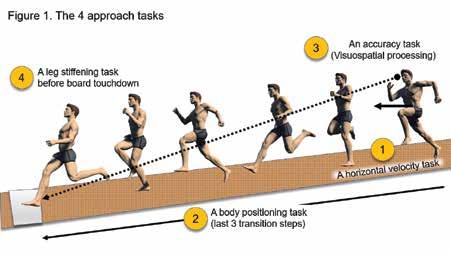
The hopping leg, and therefore potentially the jumping leg, is particularly unpredictable in children under 11 years because stabilization capacity of the leg emerges before its mobiliza tion and manipulation capacity (Previc, 1991). It is difficult to identify which leg of a child is better at stabilizing the body, and which is better at performing movements demanding mobiliza tion and manipulation until the brain has fully matured.
After stabilization, mobilization, and manipu lation features of each leg mature, the brain’s proficiently at allocating focal attention on relevant parts of the skill becomes an issue (Gabbard & Hart, 1996). Focal attention refers to the amount of attention the brain devotes to processing and acting on specific information to the exclusion of other information (Figure 5). The brain has limited capacity to shuttle the informa tion it needs to control a skill from long-term to short-term memory so it can be acted on, espe cially when the movement is extremely fast. It also has limited capacity to quickly switch atten tion between components of a skill (McElree, 2011). The amount of focal attention necessary on each component probably depends on per fection of the approach rhythm subroutine, the transition subroutine, the visual processing subroutine and the takeoff subroutine. Each subroutine become increasingly automated with practice, and this reduces the amount of brain input needed. However, the correct subroutine must be practiced. An incorrect subroutine that is highly rehearsed is hard to undo.
In summary, it might appear that the ground ed leg should be performing a stabilization, force production and postural task, it might be performing a manipulation and mobilization task. The force generated on the board is simply a consequence of the speed generated during the approach and controlled during the final 3 transi tion steps. The takeoff leg merely needs to man age the high foot-board impact ground reaction forces. As well, we lack sufficient neurological understanding about the amount of focal atten tion the brain places on: (1) the asynchronous transition steps, (2) visuospatial processing of the upcoming board, and (3) adjusting step length to correct for accumulated step error. Insufficient focal attention given to any one of these phases could affect limb action on the board by disrupt ing rhythm and timing ever so slightly. Gender

16 techniques NOVEMBER 2022

CHOOSING THE “RIGHT” LEG
and other individual differences among jumpers may also be a factor.
AGE OF BRAIN LATERALIZATION
Given that brain lateralization holds some clues about how the brain controls the legs, the age brain lateralization matures becomes a coaching consideration.
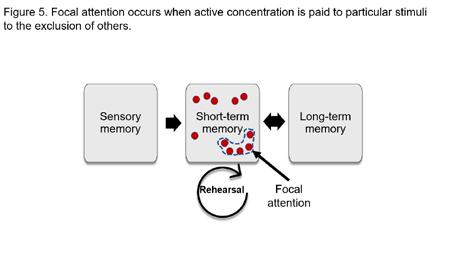

Research indicates that the brain’s hemi spheres become progressively specialized
with age (Gentry & Gabbard 1995). Before 11 years of age, many children throw and kick using both sides of the body (Figure 6). Frequency of right-footedness increases with age. Around 66% of children under 8 years are consistently right-footed versus 81% of those between 11-20 years old who are right-footed. By 11 years of age, both boys and girls appear to have a preferred side for throwing and kicking, indicating
that brain lateralization is complete.
The age at which brain lateralization matures has implications for teaching the long jump.
Practicing the takeoff using both sides of the body before 11 years of age may be a good coaching practice before making a final decision about the most effective takeoff leg (Figure 7).
Prolonged specialized long jump takeoff training before brain lateralization stabilizes may cause a jumper to practice the incorrect subroutine. Advanced metabolic, muscular and neurologi cal adaptations make it difficult to alter a wellrehearsed subroutine if changes in the takeoff leg must be made.

OTHER COMPLEXITIES
A. Interaction of eye dominance with visuospa tial processing
Most people are right-eye dominant, and therefore focus using their right eye. Most archers and shooter, for example, use their right eye to focus on the target (Loffing et al., 2014).
Eye dominance also plays a role in long jumping. However, it is moderated by visuospatial pro cessing over the final five steps of the approach to guide the jumper’s foot placement on the board. There is a natural tendency to shift spatial attention to the left (Schintu et al., 2019). Right eye dominance supports this left shift in visuo spatial attention. Left eye dominance dampens the left shift bias in visuospatial processing.
How eye dominance, in conjunction with the natural left shift of spatial attention, affects a jumper’s leg use while leaping for maximum horizontal distance is not currently understood. It potentially means that leg choice is a com promise between the jumper’s visual process ing needs, and the antigravity force production and stabilization features of the left leg (Peters, 1988). For some jumpers, eye dominance and left shift of visuospatial processing may demand a high level of brain focal attention. This potential ly reduces the ability of the takeoff leg to counter ground reaction forces and provide sufficient postural stabilization.
B. Limb and dominant eye congruence
Approximately 66% of right-hand, and 57% of left-hand people, are congruent with their dominant eye. That is, they are right-hand and right-eye dominant, or left-hand and left-eye dominant. The dominant eye provides slightly more input to the brain’s visual center, and more accurately relays information about the location of objects. However, the dominant limb of 40% of the population is not congruent with their domi nant eye. This condition can occur when the eyes are controlled by both brain hemispheres. Nerve fibers from the eye closest to the nose cross to the visual centers in the opposite hemisphere, while fibers closest to the outside of the head travel to visual centers on that side of the head.
In summary, a lack of congruence between
18 techniques NOVEMBER 2022

CHOOSING THE “RIGHT” LEG
dominant eye and dominant limb, in con junction with the visuospatial attention left shift issue, may affect the brain’s ability to divert sufficient focal attention quickly to leg actions during takeoff. This potentially impacts the effectiveness of the jumper’s takeoff leg. This suggests that the jumper must firmly establish the visuospatial pro
cessing subroutine before undertaking sig nificant training of the takeoff leg.
C. Neurological challenge of board intersection at high speed
The visuospatial processing center at the back of the brain provides the jumper with information about the shape and loca tion of the board (Figure 8). Board shape
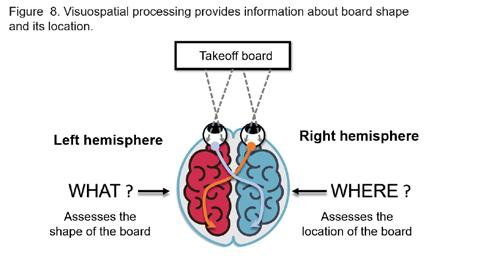
is the “WHAT” component of visuospatial processing, and the location of the board is the “WHERE” component (Peters, 1988). For right-hand dominant jumpers, the left hemi sphere processes the information about the characteristics of the board and its shape. It is about 24 milliseconds faster than the left hemisphere at this task. The right hemisphere is better at processing the location of the board. Again, it is the reverse for left hand dominant jumpers.
Not only must the brain gather informa tion about board shape and location, it must concurrently send information to the jumper about the magnitude of the accrued step error when the board is in sight (Chabris et al., 1998). It is impossible to precisely repli cate a practiced step length and approach rhythm each time. Environmental conditions and psychological arousal always differ. Many hundreds of hours of practice are necessary to reduce the neurological demand and focal attention requirements of the final five steps of the approach. When the subroutines are well rehearsed neurological demand decreas es. Nevertheless, considerable neurological processing remains.

FUNCTIONAL TESTS
By now, you are likely throwing up your arms in despair of ever getting the jumpers leg selection correct. However, three functional tests can provide some clues about how the issues just discussed interact to influence a jumper’s most effective long jump takeoff leg. Keep in mind, that there are several approach subroutines that may need to be trained before substantial takeoff practice.
Test 1: The jumper stands with both feet on a line and leans forward into a fall while trying to keep both feet ‘stuck’ on the line. One foot will eventually move in the direc tion of the fall. The foot remaining on the line indicates the potential takeoff leg. The leg moving forward indicates the potential swing leg (Figure 9).
This provides useful insight for a jumper who is beginning to develop the physi cal literacy skills specific to long jumping. However, it does not address the visuospatial complexities of precise foot placement on the takeoff board at the end of the high-speed run. Older children who are specializing in the long jump will need to combine general development of horizontal leaping skills with a takeoff target. Removing the target makes the drill non-specific to long jumping. Data from this test must be combined with the next two tests to provide richer insights.
Test 2: Use a variety of running and jump ing games that include a target the athlete must use to leap off the ground for a long
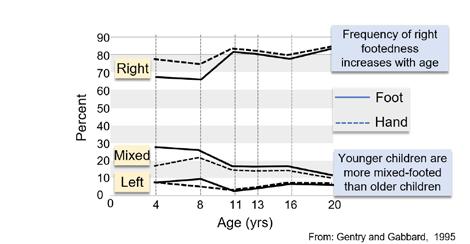
20 techniques NOVEMBER 2022
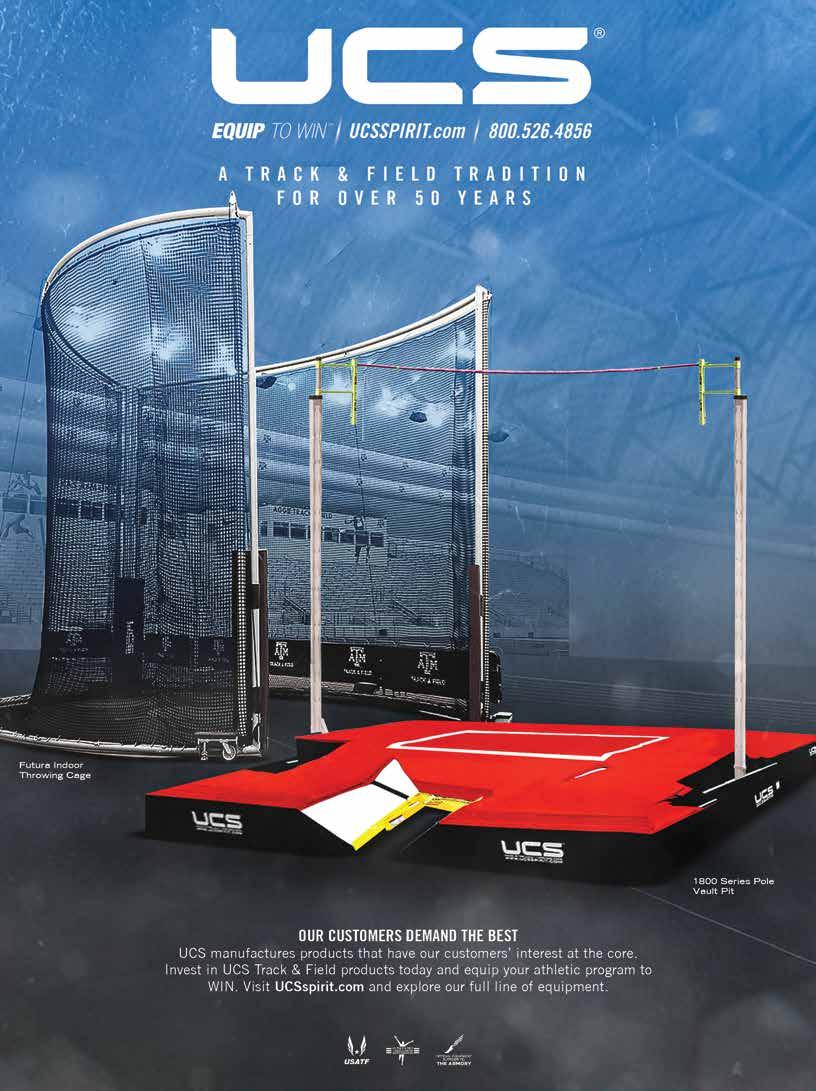
CHOOSING THE “RIGHT” LEG
step. Watch for the leg that is subconsciously selected.
Test 3: More specific data can be gathered by organizing practice and competition so the jumper alternates takeoff legs for the first year after brain lateralization is complete. Record all jumping distances. After 1 year of experi menting with each leg, select the leg that con sistently provides the longest jump, and begin focused long jump training using that leg.
It may be necessary to keep testing the athlete to determine if brain maturation and approach subroutine consolidation is altering the subconscious choice of a preferred takeoff leg or leg effectiveness in producing the lon gest jump.
KEY COACHING IMPLICATIONS
The brain’s lateralized hemisphere control over force production, stabilization, mobiliza tion and manipulation requirements of leap ing for distance cannot be isolated from the high neurological demands of board visuo spatial processing, the four approach tasks and thhree takeoff body action tasks.
Brain lateralization is not mature until around 11 years of age. This has implications for the age when a takeoff leg can be safely finalized. Until then, build alternate use of left and right legs into the jumper’s long jump practice.
The jumper’s visuospatial processing, and the asynchronous nature of the final three body position steps, must be reasonably well patterned before finalizing the takeoff leg.
Specificity of functional tests for selecting the takeoff leg require using drills that always include a target.
Perform the functional tests on a regular basis to determine if consolidation of the approach subroutines is affecting the jump
er’s preferred and most effective takeoff leg.
REFERENCES
Alonso AC, Brech GH, Bourquin AM, Greve JM. The influence of lower-limb dominance on pos tural balance. (2011) Sao Paulo Med. 129(6): 410–413.
Chabris, C. F., & Kosslyn, S. M. (1998). How do the cerebral hemispheres contribute to encod ing spatial relations? Current Directions in Psychological Science, 7(1), 8–14.
Cuk, T., Leben-Seljak, P., & Stefancic, M. (2001). Lateral asymmetry of human long bones. Variability and Evolution, 9, 19–23.
Gabbard, C., & Hart, S. (1996). A question of foot dominance. The Journal of General Psychology, 123(4), 289–296.
Gentry, V., & Gabbard, C. (1995). Footpreference behavior: a developmental perspec tive. The Journal of General Psychology, 122(1), 37–45.
Hay, J. G. (1986). The biomechanics of the long jump. Exercise and Sport Sciences Reviews, 14, 401–446.
Kapreli, E., et al (2006). Lateralization of brain activity during lower limb joints move ment. An fMRI study. NeuroImage, 32(4), 1709–1721.
Linthorne, N.P., Baker, C., Douglas, M.M., Hill, G.A., & Webster, R. (2011). Take-off forces and impulses in the long jump. Portuguese Journal of Sport Sciences Applied Biomechanics in Sports 11 (Suppl. 3), 33-36.
Loffing, F., Sölter, F., & Hagemann, N. (2014). Left preference for sport tasks does not neces sarily indicate left-handedness: sport-specific lateral preferences, relationship with handed ness and implications for laterality. Research in Behavioural Sciences. PloS One, 9(8), e105800.
McElree, B. (2001). Working Memory and Focal Attention. Journal of Experimental
Psychology. Learning, Memory, and Cognition, 27(3), 817–835.
McGrath TM, Waddington G, Scarvell JM, Ball NB, Creer R, Woods K, et al. (2016). The effect of limb dominance on lower limb functional performance – a systematic review. Journal of Sports Science. 34(4): 289–302.
Milenkovic, S., Paunovic, K., & Kocijancic, D. (2016). Laterality in living beings, hand domi nance, and cerebral lateralization.
Muraki, Y., Ae, M., Koyama, H., & Yokozawa, T. (2008). Joint Torque and Power of the Takeoff Leg in the Long Jump. International Journal of Sport and Health Science, 6, 21–32.
Mutha, P. K., Haaland, K. Y., & Sainburg, R. L. (2012). The effects of brain lateralization on motor control and adaptation. Journal of Motor Behavior, 44(6), 455–469.
Peters, M. (1988). Footedness: Asymmetries in foot preference and skill and neuropsychologi cal assessment of foot movement. Psychological Bulletin, 103(2), 179–192.
Previc FH. (1991) A general theory concern ing the prenatal origins of cerebral lateralization in humans. Psychological Review, 1,98,299–334.
Sadeghi, H., Allard, P., Prince, F., & Labelle, H. (2000). Symmetry and limb dominance in able-bodied gait: a review. Gait & Posture, 12(1), 34–45.

Schaefer, S. Y., Mutha, P. K., Haaland, K. Y., & Sainburg, R. L. (2012). Hemispheric Specialization for Movement Control Produces Dissociable Differences in Online Corrections after Stroke. Cerebral Cortex (New York, NY), 22(6), 1407–1419.
Schintu, S., Chaumillon, R., Guillaume, A., Salemme, R., Reilly, K., Pisella, L., & Farnè, A. (2019). Eye dominance modulates visuospatial attention. Neuropsychologia, 141, 107314.
Van Melick, N., Meddeler, B. M., Hoogeboom, T. J., Sanden, M. W. G. N. der, & Cingel, R. E. H. van. (2017). How to determine leg dominance: The agreement between self-reported and observed performance in healthy adults. PLOS ONE, 12(12), e0189876.
DR. CHRISTINE BROOKS IS THE LEVEL 2 SPORT SCIENCE INSTRUCTOR FOR USA TRACK AND FIELD. SHE ALSO TEACHES THE SCIENCE OF HIGH-PERFORMANCE TRAINING AT THE UNIVERSITY OF FLORIDA AND IS A SPORT SCIENCE INSTRUCTOR FOR THE UCLA PRIMARY CARE SPORTS MEDICINE FELLOWSHIP PROGRAM. SHE HAS DEVELOPED TWO COURSERA COURSES THAT FOCUS ON THE SCIENCE OF TRAINING THE YOUNG ATHLETE. OVER 30,000 COACHES HAVE GONE THROUGH THESE TWO COURSERA COURSES.
22 techniques NOVEMBER 2022



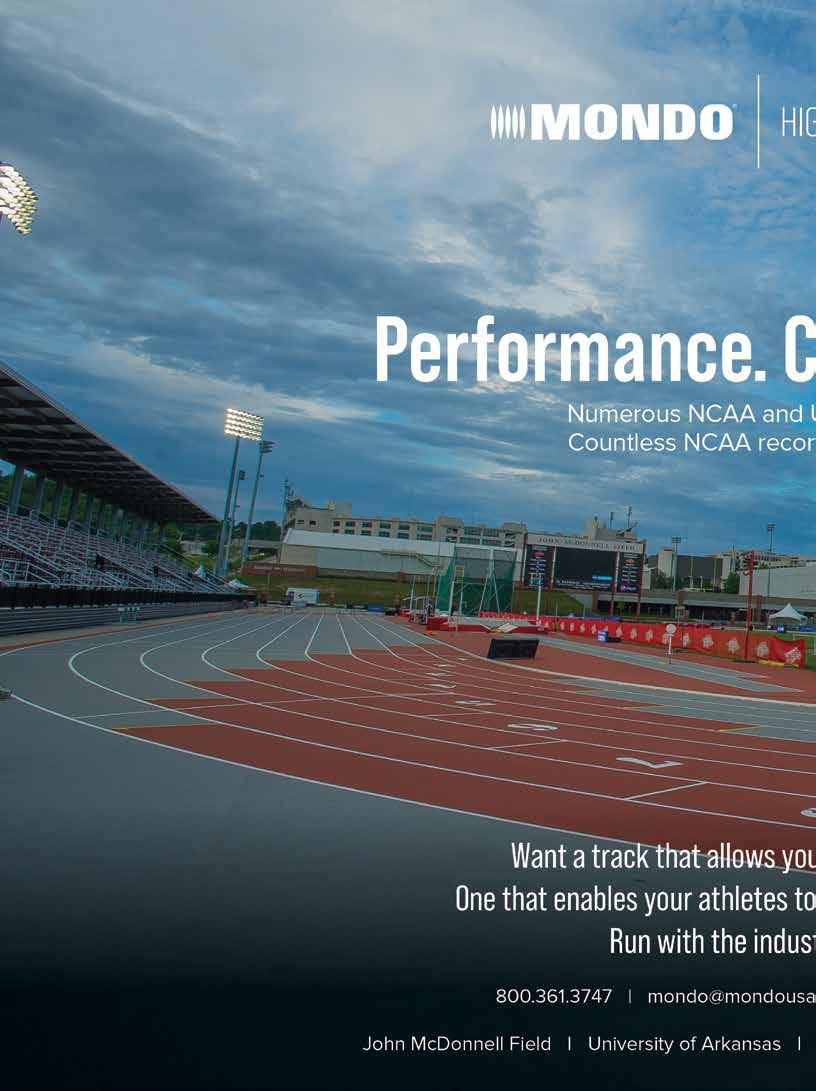

The Mozart of Hammer Throwing
Understanding the success of Yuri Georgievich Sedykh
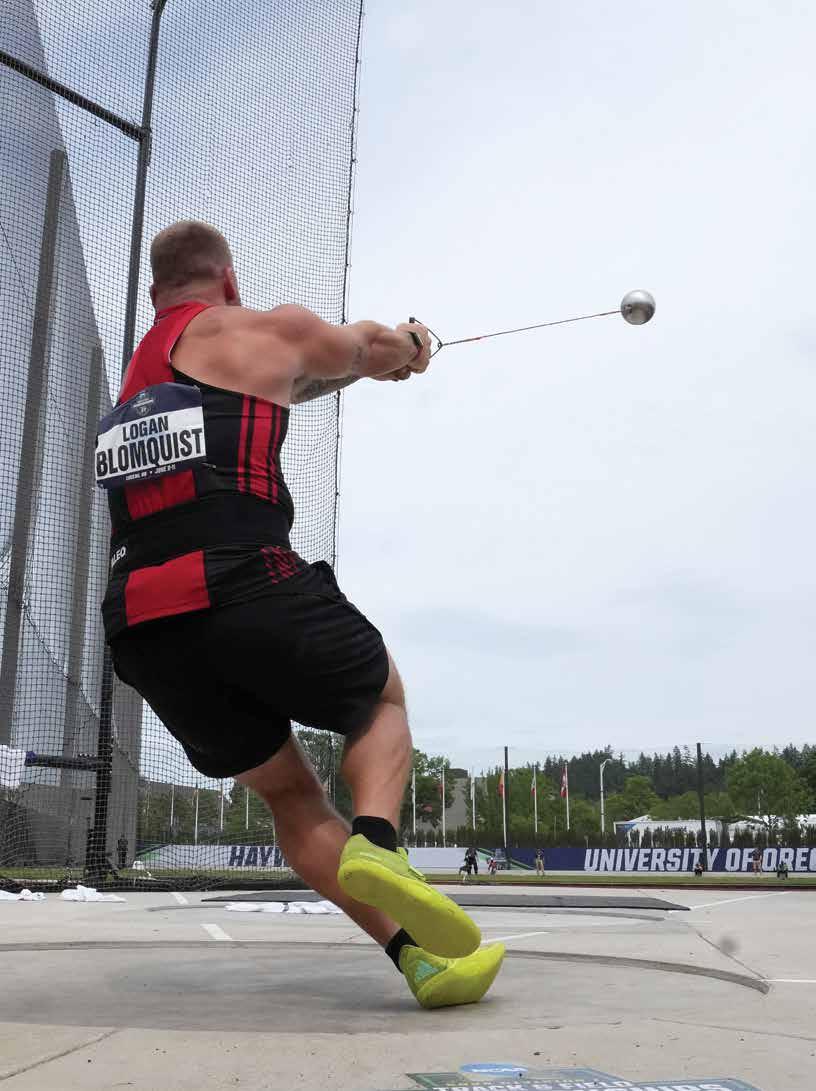
In every art, there are outstanding fig ures. Not every art, however, has had its Mozart. The art of hammer throwing is lucky to have had one! Yuri Georgievich Sedykh, the best hammer thrower in the history of this sport, left us a year ago, on September 14, 2021. The winner of two Olympics (1976 and 1980) and the silver medalist of the third (1988), he would no doubt have won a third Olympic gold, if not for the boycott of the 1984 Olympics in Los Angeles by the Soviet government. That year, Yuri was the absolute world leader in hammer throwing, with a score of 86.34 m, while the winner of the 1984 Olympics, Juha Tiainen (Finland), showed only 78.08 m. Besides his Olympic achievements, Yuri was the world champion (1991) and three times the champion of Europe (1978, 1982, and 1986). Six times he showed an official result exceeding 86m. No one has even come close to this outstanding score so far. His throw of 86.74m at the European Championship in 1986 still remains an unbroken world record. What was the secret of this outstanding ath letic career?
At least one hypothesis can be rejected at once: No, Yuri was not an unusually “strong” athlete. He told me once that physically, he was weaker than any other member of the Soviet Olympic team: “I was stronger than others in only one exercise – throwing the hammer.”
The “secret” of Yuri’s legendary success was his outstanding technique. Harold Connolly, another legend of hammer throw ing, said: “Yuri calls his technique “simple,” and when you look at it, it is very basically simple. He doesn’t have any wasted motions or movements. “
Yes, this technique was simple, simple as anything created by a genius. I was fortunate to be in a close working and friendly relation ship with Yuri during the last eight years of his life. I assisted him in his American clinics, and together we wrote several articles on physics and technique of hammer throw ing, as well as a book, “Art and Science of Hammer Throwing.”
During all these years, I have had the opportunity to test our findings by coaching hammer throwers at Springfield College in Massachusetts and working on my own tech nique (I’m still competing, now in the age –not range! – interval of 80-84).
Here, I want to share with the reader my reflections on the legacy left to us by this superb athlete and teacher. For brevity, I will call the unique Yuri’s technique “Yu-turn technique.” Any interpretation of the tech nique of an outstanding athlete is but a personal, subjective vision of the interpreter,
LEE IMAGE OF SPORT
even if there was a formal agreement of the athlete with this interpretation. I’m urging the reader to take this (and any other) inter pretation of the special technique of Yuri Sedykh critically. I will be happy to discuss any issues raised in this article (strelnitski@ yahoo.com) .
1. “ALWAYS LOOK AT THE HAMMER.” Yuri was engaged in ballroom dancing as a child, and he liked to repeat that the connec tion and “mutual understanding” between the thrower and the hammer should be as complete as between partners dancing a waltz. Like partners in a waltz, the thrower and the hammer alternate in who leads the mutual rotation. In the active phase of ham mer acceleration (hammer azimuth from about 270 to 360 degrees), the thrower is in the lead, and in the “inertial” phase (0 – 270 degrees), the pace is mainly set by the ham mer (see paragraph 3).
I never discussed this with Yuri, but recently the thought occurred to me that there is still an important difference between a hammer throw and a dance: partners in ballroom dancing never look each other in the face, whereas one of the most important features of the Yu-turn technique is just the requirement that in turns the thrower should always look towards the hammer.
Unfortunately, during the “Sturm und Drang” era of the 1970s-80s, when world records exploded (largely thanks to Soviet throwers), Yuri was practically the only one who followed this rule. Look at those historic photos of elite throwers of that time show ing the moment of their right foot landing. Turning the head to the left, away from the hammer, was typical. Turning away from the hammer leads to some degree of “dragging” it, which decreases the vital parameter for a long throw—the radius of hammer rotation.
It’s certainly trying to imitate Yuri that many contemporary elite throwers don’t commit this mistake. If the athlete is not instructed from the outset to look towards the hammer, getting rid of this fault will be more and more difficult in the future. When I asked Yuri how he came to this good habit of always looking at the hammer, he replied: “I don’t know. Somehow, I looked at it from the very beginning.” From my multi-year experi ence as a coach, I don’t remember a single case where a beginner would, by themselves, without insistent reminders from the coach, look towards the hammer throughout the turns. Was this amazing deviation of Yuri from the general tendency already a sig nature of an emerging genius of hammer throwing?
Another condition for a good connection
between the thrower and the hammer is the correct, full countering of the pull from the hammer by the body. This problem is also known as the problem of balance.
2. THE PROBLEM OF BALANCE. Yuri was mentioning the problem of balance rarely at his clinics, and one might get the (wrong) impression that he did not see this problem as important. I have always consid ered a good balance as the most fundamen tal condition for a good throw, and I asked Yuri once how he managed to achieve such perfect balance in movement. He said: “My first coach [V.I. Volovik] paid a lot of atten tion to our balance drills.”
In his DVD “13 Simple Answers to 13 Hard Problems” Yuri says: “You should always find balance between you and the hammer,” and he elaborates that this is achieved by correct body positions, specific for each phase of the throw. He especially emphasized the neces sity to “open to the left” while passing from the double support to the single support. Insufficient “opening” of the body during the transition to the single support is a typical mistake that leads to the loss of balance and a “fall” on the right foot when it lands. The body opening should increase from turn to turn, together with the increasing centrifugal pull from the hammer. The opening of Yuri’s body in the second, and especially the third, turn of his 80-m throws is so full that it looks like he almost “lays back” when the hammer approaches its high point.
Countering the pull from the hammer around its high point is also helped by the “collapse” of the left knee. One of the sig nature features of the Yu-turn technique is a very deep collapse of the left knee. In the third turn of an 80-m throw, Yuri’s left knee almost touches the ground, just before his right foot lands. The downward drop of the center of mass (COM) of the body due to the collapse of the left knee counteracts the upward pull from the hammer, provid ing a better balance of forces in this phase. In addition, it reduces the distance of the right foot from the ground, which allows the thrower to outrun the hammer and land the right foot faster.
In the opposite phase of the turn, when the hammer is in the vicinity of its low point and the thrower’s body passes through the symmetrical “neutral” position, the dynamic balance between the thrower and the ham mer is achieved by a sufficiently deep sitting back. A detailed quantitative study of the forces and torques in the system hammer/ thrower around the neutral position was performed by us in 2017. The results are presented in our book (pp. 84-96). The major conclusion is: The required depth of sitting
NOVEMBER 2022 techniques 29 KIRBY
THE MOZART OF HAMMER THROWING
back depends on the individual anthropo metrical parameters, and it should be found out individually, by trial and error, but, typically, in the neutral position the angle between the thighs of the thrower and the horizontal plane that passes through the knees should be around 60 (+/- 5) degrees.
The great majority of beginners tend to sit back much less than that. The explanation of this tendency is quite simple. For a suf ficient sitting back, the body’s COM (which in the neutral position is slightly outside of the navel) must be brought back beyond the line of the heels. Without the pull from the hammer, such a position of the body would be unstable, because the fundamental condition of stability is broken: the body’s COM projects beyond the area of support. A deeply rooted self-preservation reflex resists assuming such a position, and it takes time and many bold attempts for the thrower to become convinced that the forward pull from the hammer will prevent the body from fall ing back, even if the thrower moves the COM far beyond the line of the heels.
It is seen in slow motion videos how deep ly Yuri sits back entering into the first turn. It is also seen that he does this with a consid erable acceleration of his pelvis, so that his body arrives at the neutral position slightly before the hammer hits its low point. It is the correct sequence of events, theoretically sub stantiated in the author’s paper in the August 2019 issue of Techniques Magazine
3. “THE HAMMER IS A PENDULUM!”
By the time of my first meeting with Yuri, I had already been thinking about the physi cal foundations of hammer throwing for quite some time. One of the thoughts that occupied me at the time was my surprise that none of the published articles and books on the technique of hammer throw ing mentioned the pendulum component in the motion of the hammer, the component whose presence was obvious to me. Imagine my surprise when Yuri’s first statement at our first meeting was: “The hammer is a pendulum.” That was the moment when I already knew for sure that we would be working on a book together!
The desired optimum hammer release angle of 45 degrees requires that its hori zontal (forward) and vertical (upward) final speeds be approximately equal. It can be shown that the optimum strategy is to gradu ally increase both velocity components in each turn (see: Strelnitski, V., “Hammer: the Tilt of the Orbit,” Techniques for Track
& Field and Cross Country, vol. 19, #4, pp. 11-18). However, there is an important dif ference in the character of acceleration of the two velocity components. The acceleration of the horizontal component is totally con trolled by the thrower, whereas the vertical component is also affected by gravity. Gravity helps to accelerate the hammer vertically when it moves from its high point to its low point, but it decelerates the hammer on the rising half of the orbit. These up and down oscillations of the hammer in the gravitation al field, combined with its horizontal rotation and the efforts of the thrower to accelerate it, make it, from the point of view of physics, a “forced rotational pendulum.”
The thrower must match the rhythm of their efforts with the natural rhythm of the pendulum, meeting the requirement that one full turn with the hammer must occur exactly during one full pendulum swing. But the pendulum nature of the hammer’s motion also provides good news for the thrower: the deceleration of the hammer on the rising part of its orbit, due to gravity, causes the hammer to “hang” around its high point, and the thrower can (and should!) use this deceleration to outrun the hammer smoothly, without hurry.
4. THE “DIFFERENTIAL” MOTION OF THE UPPER AND LOWER BODY.
Let us dwell a little on this smooth and unhurried outrunning of the hammer in the single support phase, the feature in which Yuri excelled. In slow motion videos (see references), Yuri appears to have much more time to complete this phase of the throw than other throwers. The upper body is firm ly connected to the hammer and performs a cone-shaped movement, like a “wobbling” child’s top, while the lower body, driven by the powerful push of the right thigh, smooth ly outruns the upper body and the hammer.
How different this performance, perfect even aesthetically, is from what most other throwers do, including the elite ones! One can single out two typical faults. Some throwers turn both parts of the body almost together (Yuri called the body of such throw ers “wooden”), which doesn’t allow them to outrun the hammer sufficiently. At the moment of right foot landing, the hammer is already close to its low point, and its sub sequent short acceleration by the thrower is not efficient. Some others rush to land the right foot, not caring about the motion of the hammer during this hasty step forward. In this case, the thrower tends to “fall” on the
right foot which touches the ground in an “open” position (pointing towards the front part of the circle), and even if the hammer at the moment of the right foot landing is still high, the beginning of the power phase will in this case be “jerky” and inefficient (see more in sub-section 6.3).
Once, I showed Yuri his execution of the single support phase in a slow motion video of one of his throws and said that I had found out that the amazingly rational movement of his body in this phase is well described by the physical theory of a “precessing” (wob bling) top. He looked at the video quickly, then at me, and said: “This cannot be taught.”
During the time of our joint work, there were a few statements by Yuri with which I did not agree at once. However, all of them, but this one, were eventually accepted by me, after some reflection. I still don’t want to accept this discouraging statement. I’m stubbornly trying to understand and repli cate Yuri’s unhurried differential movement of the lower body relative to the upper body in the single support phase, and I’m try ing to help my students do it. I want Yuri to be wrong in this single case! There is little hope, and yet it seems to me worth trying— even if not to achieve Yuri’s perfection of movement, but at least to find the key to its essence. The solution may be simpler than we think. After all, the children’s top begins its cone-like precessional motion from a simple light push on it. The projection of its COM goes then beyond the area of support, and this is enough for the precession to start automatically. May it be enough to sit in a single-support phase more back, on the left leg, to bring your COM beyond the area of support (the toe of the left foot) and just not hinder the starting body precession?...
5. THREE VERSUS FOUR.
Yuri Sedykh has long been a legend and an icon of hammer throwers. Many tried to imi tate his superb technique, or at least some elements of this technique. Yet, there is one element that practically none of the elite throwers has been trying to follow, so that it gradually became a kind of half-forgotten and insignificant curiosity of the idol’s tech nique, a technique that is hugely attractive in all other respects.
This “odd” technical element of Yu-turn technique is throwing from three turns. When I asked Yuri once why he didn’t follow the general trend to switch to four turns, he replied: “I tried, but somehow it didn’t work
30 techniques NOVEMBER 2022

for me.” I did find one movie online: https://www.youtube.com/ watch?v=xlQwU1_vg40
At the very end of this long movie, young Yuri throws from four turns. His technique there looks not worse than that of the best 4-turners of the time. But… where is this powerful Sedykh’s entry into turns? Where is this complete freedom of traveling across the circle (which Yuri himself described as a “flight with the hammer”)? Where is Sedykh’s unique outrunning of the hammer, when, at the moment of landing of the right foot, the hammer is still far behind the azimuth of 270 degrees?!
I think it’s a mistake to avoid attempts by coaches and athletes to reach the Olympic level by throwing from three turns, as Yuri did. Didn’t Yuri, with his outstanding achievements, prove strictly that the fourth (toe) turn is simply not needed?
6. THE MISUNDERSTOOD YURI.
As I noted before, in our numerous con versations about the technique of hammer throwing, I did not always agree with Yuri’s statements right away. However, all the cases of disagreement (with the possible exception of one), after more or less lengthy delibera tion or scientific study, were decided in his favor, and often resulted in new publica tions. Below, I give several examples of my (resolved) misunderstanding and of mis understanding by other admirers of Yuri’s talent.
6.1. “Push the hammer!”
This is perhaps the most famous phrase of Yuri, which is remembered by many partici pants of his numerous clinics. From the very beginning of our collaboration, I had prob lems with this call of the master. An elemen tary physical analysis shows that the hammer can only be accelerated by “pulling” it, not by “pushing” (see pages 15-17 of our book).
It took me more research to understand the sense of the “pushing” in Yuri’s call. It is associated with the always desirable increase in the “drive radius” of the hammer.1 It can be shown that when the “triangle” of the arms rigidly connected to the torso actively presses the hammer’s handle to the left (for a right-handed thrower) at the segment of active acceleration (hammer azimuth 270360 degrees), the drive radius increases, in comparison with the case of passive arms serving as the mere continuation of the wire. More details can be found in our book (pp. 78-80) and in our article “Hammer Throw: Legs or Arms” (Strelnitski, V. & Sedykh Yu.,
2018, Track Coach, #224, pp. 7146-7148)
An important remark should be made here. Some coaches take the call to use the arms actively as applicable to throwers of any skill level. My coaching experience has shown that the call to “push” (or “swing”) the hammer with the arms makes sense only for throwers of a sufficiently high technical level who have already achieved complete automatism in maintaining the balance with the hammer by the correct work of the legs and the body, in particular, sitting back suf ficiently during the active acceleration of the hammer. When the throwers deficient in experience try to “push” (or “swing”) the hammer by the arms, they tend to sit back insufficiently, which unavoidably results in the loss of balance, impossibility to outrun the hammer well, and “falling” on the right foot at its landing.
6.2. “KEEP THE HAMMER IN THE FIRST TURN FLATTER.”
As a coach, Yuri adhered to an important (and, unfortunately, not often observed) principle: not overloading the athlete with an excess of comments, trying to understand the main flaw of the athlete and draw their attention to it. His most important remark to me personally was to keep the hammer in the first turn “flatter.” He added then that the steepness of the initial orbit of the ham mer should correspond with the length of the throw achievable by the athlete: the shorter the length of the throw, the flatter the first turn should be. At first, this remark seemed strange to me: after all, Yuri himself has a very steep first orbit, about 35 degrees. How will I, starting the throw flat, with the tilt, say, 15 degrees, achieve the desired final 45 degrees?
Yet, trying, on Yuri’s advice, to keep the initial orbit flatter has appreciably improved my connection with the hammer, which, in its turn, improved the results, and I began to reflect, as a physicist, on Yuri’s remark. It was a very interesting investigation! I realized that Yuri was absolutely right, and I published my results in the article cited in paragraph 3.
The “drive radius” is the momentary radius of the curve along which is pulled the point of attachment of the “lash” of the ham mer as a whip, to the “handle” of the whip. This radius is always considerably smaller than the radius of the orbit of the hammer’s head. With a given magnitude of the pulling force, the acceleration of the hammer’s head along its orbit increases proportionally to the drive radius. See more in our book (pp. 15-17
and 78-80).
The main result was the establishment of the fact that the maximum inclination of the first orbit, at which good connection of the thrower with the hammer is still possible, increases with the increase in the speed of the hammer that the thrower is capable to develop entering into the first turn, without losing balance in this and subsequent turns. A beginner thrower cannot develop a high entry speed without losing the balance in the turns; therefore, if they want to have a good connection with the hammer, their first orbit must be flat. Since, due to the law of conser vation of angular momentum, the increase in orbital inclination from turn to turn must be gradual, for such a thrower the final inclina tion of the orbit is limited, too. Therefore, both the thrower and the coach must come to terms with the relative flatness of the first throws, paying their main attention to a good connection of the thrower with the hammer. The speed of the turns and the steepness of the orbit of the hammer will naturally grow as the technical level of the thrower grows.
For more details about the result of this study inspired by Yuri, I refer the interested reader to the article cited above.
I would like to point out one more appli cation of that study. It concerns the choice between three and four turns. The fact is that, purely technically, it is more difficult to increase the inclination of the first orbit in the toe first turn than in the heel first turn. Together with the difficulty to develop a high entry speed in the toe entry (see subsection 2.4.5 on page 46 of our book), as well as with the requirement for a gradual steepening of the orbit from turn to turn, it becomes clear why even in experienced, elite 4-turn ers, the final angle of the hammer release is usually noticeably less than the desired 45 degrees. The best 4-turner ever was Sergey Litvinov. The final speed of his hammer was comparable to that of Yuri Sedykh, but the release angle was a few degrees less, which may explain why his best throws were, in the average, 1-2 m shorter.
6.3. “NO FOOTWORK!”
While working on our book, Yuri and I dis cussed, among other problems of teaching the hammer throwing, the very common practice of coaches to start training with teaching the “footwork.” We came to the mutual conclusion that the study of footwork should not be separated from the study of the corresponding positions of the hammer. As we write in our book, “these two elements of
32 techniques NOVEMBER 2022
THE MOZART OF HAMMER THROWING

a turn are absolutely inseparable and, from the very beginning, they should be studied together and in motion.”
To my surprise, some coaches have inter preted this as Yuri’s call to ignore the study of the footwork at all, because when some core idea of how to accelerate the hammer with the arms is understood by the student, their body, legs and feet will “adjust” auto matically.
This is an obvious misrepresentation. Yuri repeatedly pointed out the need for proper footwork. A prime example is his descrip tion of how hard he worked on getting his right foot on the ground correctly (on the toe instead of the heel), as taught to him by his coach, A.P. Bondarchuk (see p. 63 in our book).
Another example is his explanation (in his DVD “13 Simple Answers”) of how in turns the left foot (heel) and the right foot (toe) should start their rotation simultaneously and exactly at the moment of the low point of the hammer.
Yuri also often emphasized that the thrower should try to keep the right foot in a “closed” position, in particular, before the entry into the first turn and at the landing of the right foot in turns. Some commentators point out that, based on the available videos, Yuri himself never landed his right foot in a fully closed position, and, on this basis, they recommend ignoring Yuri’s verbal call and imitating his actual “open” execution of the right foot landing. I will give two arguments against such an approach to Yuri’s words and actions, one based on the statements of Yuri himself, and the other based on my own analysis of the issue.
Yuri used to tell me: “Many people try to imitate me by looking at static pictures that captured some intermediate body position. They think that I deliberately took these posi tions, but this is not true. When you throw beyond 80 meters, everything happens so fast that thinking where and how exactly to place your foot is impossible. I just tried to follow some of my own cues, and to which positions of feet or body it led exactly was the least of my concern.”
Now, why did Yuri repeat that the right foot should be kept in the closed position (and it’s true, he did insist on that)?
I’m pretty sure that it was connected with the peculiarities of the motion of the right leg after the neutral position. It’s clearly seen in the slow motion movies available on the Internet (see references below) that immedi
ately after passing the neutral position, Yuri’s right hip and knee turn decisively inward, towards the left leg, so that by the time the right leg is lifted off the ground, the knees are nearly joined. The closeness of the legs to each other in the single support phase is a very important feature of Yu-turn technique. The compactness of the lower body reduces its inertial properties (“moment of inertia”), which makes it easier for the lower body to outrun the implement. The same historical videos demonstrate that most of other elite throwers of the time did not carry their right leg so close to the left leg, which may, at least partly, explain why Yuri’s outrunning of the hammer was so much better than everyone else’s.
It’s now becoming clear why Yuri insisted on the closed position of the right foot at the neutral position: it’s required for the subsequent fast turn of the right thigh and knee inward. In Yuri’s DVD and in the online videos where he demonstrates the technique of the turns slowly, he always lands his right foot in a completely closed position. The extremely high turning speed in the record throws did not allow the foot to be twisted up to full closeness by the time of landing, but the videos clearly show that the twisting of the foot “in” is continued after landing, so that by the time of the neutral position the right foot is completely “closed.” In his DVD Yuri shows the position of his right foot at the moment of landing (yes, it is NOT completely closed, in that case) and says: “My foot is more closed than that of other throwers.”
The recommendation to deliberately land the right foot “open” is a serious mistake based on misunderstanding. Following this recommendation will certainly lead to the lag of the right leg in the single support phase and, as a result, to a poor outrunning of the hammer by the thrower.
6.4. “IT’S AS SIMPLE AS WALKING.”
Yuri sometimes said that, for him, turning with the hammer had long become as auto matic a process as simple walking. To my surprise, some people seem to take this com parison literally, claiming that, technically, simple walking is a good model for the turns with the hammer.
Let me mention just one misleading conclusion from this analogy: that in both walking and hammer throwing the single support phase causes an imminent fall from the stance leg, and the fall is prevented by stepping with the swing leg under the fall
ing body. When walking, the body is indeed in an unstable position at the moment the swing leg is placed on the ground. However, in hammer throwing, the body position should be stable at the moment of right foot landing, the weight of the thrower continuing to load the stance (left) leg. “Falling” onto the swing leg is a well known serious fault. It drastically reduces the efficiency of hammer acceleration in the subsequent double sup port phase.
Walking is a natural process whose goal is the transference of the body in space. Hammer throwing is an artificial process whose goal is tossing the hammer as far as possible. It is dangerous to look for far-reach ing analogies between two such essentially different processes. Hammer throwing is an original art and it should be taken and taught as such.
And, in conclusion, the main points of the technical heritage of Yuri Sedykh as they appear to the author:
1. A full connection and a dynamical bal ance between the hammer and the thrower’s body are of paramount importance;
2. In turns, the sight should always be directed towards the hammer; 3. Symmetrical “neutral position” of the body with a “closed” right foot at the moment the hammer passes its low point;
4. The hammer should be “pushed” to the left by the arms at the power phase of the entry and turns;
5. The legs move very close to each other in the single support phase; 6. The hammerpendulum’s “hanging” around its high point should be used to outrun the hammer with out hurrying;
7. Three turns suffice for achieving the highest results.
Here are two websites where the reader can find videos showing the throws of Yuri Sedykh, including slow motion fragments: www.youtube.com/watch?v=DY9XDPa4JMI www.youtube.com/watch?v=mTlReluteEQ
34 techniques NOVEMBER 2022
THE MOZART OF HAMMER THROWING
DR. VLADIMIR STRELNITSKI IS AN AUTHOR, PHYSICIST, AND CURRENT VOLUNTEER COACH AT SPRINGFIELD COLLEGE. HIS BOOK, “ART AND SCIENCE OF HAMMER THROWING” WAS CO-WRITTEN WITH EUROPEAN, WORLD, AND OLYMPIC CHAMPION (SOVIET UNION), YURI SEDYKH.

 KIRBY LEE IMAGE
KIRBY LEE IMAGE
OF
SPORT
Training Top Level Hurdlers
Coach Thorson details the leading factors in the success of 400-meter hurdlers at the University of Mary
Tohe 400-meter hurdles are considered one of the most demanding, difficult and challenging of all events in track and field. There is no other event that requires an athlete to perform difficult techni cal skills while in anaerobic distress like the 400-meter hurdles. It is also an event that has a huge margin for error. Curtis Frye, the Hall of Fame and former Olympic coach from the University of South Carolina, characterized the 400-meter hurdles best when he said, “To com pete in the event, you have to be a long jumper, a high jumper, with the ability to train like an 800-meter runner, and have enough fast twitch to train like a sprinter.” With that thought in mind, it is only natural that it can be extremely demanding for a coach to design and imple ment successful training programs for top level 400-meter hurdlers.
The objective of this article is to illustrate the training, techniques and concepts that led to success for the University of Mary long hur dlers. Our training program was designed and customized to meet the needs of the Mary one lap hurdlers in their own particular setting and training environment. Although many of the concepts and components will work in nearly all programs, it would most certainly need to be tailored (as all training programs do) to meet the demands of other athletes and programs. This article will specifically detail the Mary 400-meter hurdle training principles. It will also include other training considerations, as well as key workouts and a sample training week.
The Mary 400-meter hurdle training program was constructed around the following six key principles.
1. THE LONG HURDLER MUST BE TRAINED TO RUN AN EXCELLENT OPEN 400 METERS. THE RACE MANAGEMENT SKILLS THAT A 400METER RUNNER UTILIZES ALSO MUST BE EMPLOYED BY THE 400-METER HURDLER.
• The best way to improve performance in the 400 hurdles is to improve fatigue velocity.
• The coach and athlete must understand that the one lap hurdle race is a 400 meter sprint that includes 10 hurdles. Adding the hurdles to the 400-meter equation totally changes the dynam
ic, but it is still a one-lap race and athletes must be prepared accordingly.
2. Technical hurdle skills and mechanics must be trained using both legs.
• The hurdler must be trained to alternate legs. “The most valuable skill you can teach a developing hurdler is the ability to alternate lead legs over consecutive hurdles,” according to the late Ralph Lindeman from the Air Force Academy, a coach who was a very noted hurdle authority.
• The hurdler should be directed to hurdle in training with the non-preferred leg, or second ary leg, as it is referred to by some coaches, so that they are prepared to execute both in com petition. Too many coaches allow their hurdlers to rely on the preferred leg in training, and it typically comes back to haunt them in competi tion.
• Inefficient hurdle mechanics waste valu able energy resources that are needed in the event and are responsible for unneeded braking forces. Technical hurdle skills should be trained on a consistent basis throughout the year.
• One of our basic coaching cues to our 400 hurdlers was to lead with the knee and acceler ate the last several strides into the hurdle. The goal is to negotiate the hurdle with the least amount of deviation from the sprint stride.
THE 400- HURDLER MUST BE TRAINED AS A SPRINTER AND THERE MUST BE A STEADY DIET OF SPRINT MECHANICS.
• Front-side mechanics should be maxi mized, and back-side mechanics minimized. Just as in the sprints and short hurdle races, an excellent indicator of how well the athlete is shifting their movements toward the front of the body is the amount of knee separation on touchdown.
• One of the best methods to improve non-fatigue velocity for long hurdlers is to improve maximum velocity in the short sprints. Enhancing maximum speed improves both sub- maximum speed and acceleration. As the Hall of Fame hurdle/sprint coach Gary Winckler always said, “A 400 -hurdle coach should be consistently building a better sprinter.”
• Acceleration mechanics and drills should be
a fixture on the training menu for 400 hurdlers.
• A large percentage of training time should be devoted to sprint mechanics. This is an area that is under-coached at all levels, according to Winckler. The former University of Illinois and Florida State coach goes on to say that the longer the event, the more steps it will require to cover the distance. It stands to reason, he says, that the more efficient the runner can be with each step, there will be a higher likelihood of improvement, efficiency and performance.
• Minimizing ground time is a major factor in producing fast 400 hurdle times and main taining the needed higher levels of horizontal velocity. This obviously requires a large amount of strength and energy and results in a compro mise between balancing speed in the 400-meter race with the available speed endurance.
THE ATHLETE MUST BE TRAINED TO HURDLE AND MAINTAIN FOCUS IN A FATIGUED STATE.
• Hurdling in a fatigued state can be extreme ly challenging and the athlete must experience this in training to develop the coping skills that will be needed in competition.
• A sizable portion of the fatigue-based train ing should be completed over combinations of hurdles at hurdle tempo pace instead of sprint tempo. Fatigue-based training should include a great deal of training over different combina tions of hurdles that include the athlete running not only at the desired stride pattern, but mak ing the transition to the alternate stride patterns as well. Replicating in training the stride pat terns that will be enacted in competition is cen tral to success in the long hurdle race.
• The 400 hurdler must be trained to make adjustments/ decisions and not be dis tracted by forced changes in stride pattern due to any number of uncontrollable factors. Concentration and the ability to maintain focus are characteristics of great intermediate hur dlers.
NOVEMBER 2022 techniques 37
ATHLETES MUST HAVE A PREARRANGED, REHEARSED RACE PLAN AND STRATEGIES FOR HOW THEY WILL MANAGE THE RACE AND MAKE THE NEEDED TRANSITIONS.
• 400 hurdlers must possess excellent kin esthetic abilities in order to modify and adapt their stride pattern based on weather, lane assignment and technical issues.
• There are many types of race models and stride patterns that can be implemented. A stride pattern of 13 strides between hurdles for men and 15 for women is commonly used by elite long hurdlers. The pattern typically transi tions to 14 and 16, respectively, as the athlete fatigues and the hurdler begins to alternate, normally between the sixth and seventh hur dlers for high level performers. The transition could be hurdle 5 or 6 for less experienced hurdlers. It is certainly better to have a planned program transition than a “forced” transition. There are many types of patterns and race models that can be used by elite hurdlers. Several examples that demonstrate this: former world record holder Kevin Young used the following pattern when he ran 46.78 to win the 1992 Olympic gold: 20 strides to the first hurdle, 13 strides to 2-3, 12 strides to 4-5, and 13 strides to 6-10. Silver medalist and runner up to world record-holder Karsten Warholm of Norway, Rai Benjamin of the USA uses a rightleg lead 13-stride pattern. As does Warholm, the men’s world record holder at 45.94. Dalilah Muhammad of the USA, the gold medalist in the 400 hurdles at Rio, used 15 strides for hurdles 1-8 and 16 strides for 9 and 10 when she set a women’s world record in 2019.
• The ideal stride pattern would be an odd number of steps between all hurdles. The 13, 15, 17, 19 stride pattern assures that the hurdler will take all the barriers with the same left leg.
• An even number stride pattern will force the hurdler to alternate consecutive hurdles.
• The hurdler who leads with the left leg will have a definite advantage, with less distance to run on the corners and the fact that no adjustment needs to be made with the hurdler “squaring up” to the hurdle. A right leg lead will require the athlete to run further out in the lane and can create undesirable rotation upon landing. Thus, all developing hurdlers should be taught to use a left leg lead and have the ability to alternate when factors such as fatigue and weather dictate that.
• The following information can be used to determine the optimal number of strides to the first hurdle and the resulting stride pattern between the barriers:
21 Strides to First hurdle—13 Strides Between
22 Strides to First Hurdle—14 Strides Between
23 Strides to First Hurdle—15 Strides Between
24 Strides to First Hurdle—16 Strides Between
25 Strides to First Hurdle—17 Strides Between
• Race Distribution: A relatively even-paced race model is the most efficient manner to run
the intermediate hurdle race. Both the athlete and coach must understand this. A coach can effectively monitor this using touchdown times. These can be recorded and then reviewed and analyzed in a debriefing with the athlete, using the assistance of video to correct errors and to determine late-race adjustments. An excellent “tool” for the coach is to use 200 meter split times. Ideally, according to most coaches, the difference in times for the first and second half of the race should be no more than 5%. As an example, that would be approximately 2.5 seconds in a 50 second 400 Hurdle race. One of the keys to a successful race plan is to control the energy distribution the first 150 meters of the race. We always advocated, however, for a fairly fast start. But with a healthy dose of real ism. There is no need to go out in 24.25 for the first 200 meters like Sydney McLaughlin did in her world record 50.68 clocking at the World Championships in Eugene, Oregon if you are a female running 61 second 400-meter hurdle times. Hurdle 4 is the 150- meter mark in the 400 hurdle race and an excellent checkmark.
• A hurdler must make stride adjustments well in advance of the hurdle and not in the last few strides to the barrier. Last second adjust ments and modifications typically result in poor hurdle clearance and a failure to maintain a smooth running rhythm and the correct stride pattern.
A VERY CONSISTENT APPROACH AND STRIDE PATTERN TO THE FIRST HURDLE IS VITALLY IMPORTANT AND MUST BE REHEARSED REPEATEDLY.
• The acceleration and stride pattern to the first hurdle is important to establish the proper rhythm and stride pattern between hurdles. The first hurdle approach and clearance sets the tone for the entire race. We always emphasized to our hurdlers the importance of establishing the proper rhythm to hurdles 1-2, with success over the first two hurdles typically resulting in an excellent performance for a well prepared athlete.
• Elite male hurdlers will use 20-22 strides to the first hurdle. Elite female hurdlers will typi cally employ 22-25 strides to the first hurdle.
• The lead leg will be in the back block if the hurdler uses an even number of strides to the first hurdle. The lead leg will be in the front block if the hurdler uses an uneven or odd number of strides.
• Both the coach and the athlete should be alert to the fact that a well- rested athlete can eliminate an entire stride to the first hurdle. A wind at the back of the hurdler or an athlete who is very energized and “highly aroused” in a high-level competition can also eliminate a
stride. I have also seen athletes that had to add a stride due to wind or a poor start.
• A useful tool to determine the number of strides to the first hurdle is to put a mark on the track at approximately 43.40 meters from the start and have the athlete attempt to hit it with the desired takeoff without a first hurdle present. Tape or some other item can mark the location of the first hurdle at the 45-meter mark.
KEY WORKOUTS
We are always reluctant to share training because of “monkey-see, monkey-do” coaches and their lack of context, but we have listed several workouts that have worked well for our 400 hurdlers throughout the years. The goal for all our training sessions is to have a positive experience; a positive outcome that leads to success in competitions.
1. 1 x 350m @ Race Pace w/ spikes with Hurdles 1-4 (15 minutes recovery); 2 x 300m @ 98% w/spikes (10-12 minutes recovery)
2. Flying 30’s w/spikes followed by 1 x 300m @ 98% w/spikes (10 minutes recovery) 2 x 3 x 200m w/flats@ 85% (2 minutes recov ery/4 minutes recovery for set) High Volume Workout (High for our program because we are very low volume): 1500m (Should likely be done in a period where there are no meets to prepare for)
3. Flying 30’s w/spikes followed by 1 x 300m @ Race Pace w/spikes with Hurdles 1-5 or random if indoors (12-15 minutes recovery) 2 x 300m @ 85% w/flats (5 minutes recovery)
4. 1 x 350m @ 90% w/spikes (12 minutes recovery) 1 x 200m @ 95% w/spikes (10 min utes recovery) 1 x 200m w/spikes @ Race Pace w /Hurdles 1-2
5. In & Outs w/spikes followed by 1 x 350m @98% w/spikes (12-15 minutes recovery) 3 x 150m @ Race Pace w/ Hurdles 1-2 (4-5 min utes recovery) Workout can be done by run ning hurdles 8-9-10 and finish as well instead of running Hurdles 1-2
6. 1 x 300m @ Race Pace w/spikes w/ Hurdles 1-5 (12-15 minutes recovery) 1 x 300m @ 98% w/spikes
7. Hurdle 1 x 3 from start@ Race Pace fol lowed by 1 x 350m @ 90% w/spikes(12 minutes recovery) 1 x 250m @ 95% w/spikes (10 min utes ) 1 x 150m @ 98% (Progressive Workout where intensity increases each interval)
8. Flying 30’s w/spikes followed by 1 x 350 @ Race Pace w/spikes w/ Hurdles 1-6 (15 minutes recovery) 1 x 300m @98% w/spikes (12 minutes recovery) 2 x 150m @ Race Pace w/spikes w/ Hurdles 1-2 or hurdles 8 & 9 (5-6 minutes recovery)
9. 1 x 150m @ Race Pace w/spikes w/
38 techniques NOVEMBER 2022
TRAINING TOP LEVEL HURDLERS
Hurdles 1-2 (6 minutes recovery) 1 x 200m @ Race Pace w/spikes w/ Hurdles 1-3 (10 min utes recovery) 1 x 300m @ Race Pace w/spikes w/ Hurdles 1-5 Can modify and do Hurdles 6-10
SAMPLE TRAINING WEEK 29 - APRIL 3-9
Although training should always be viewed in context, customized, and tailored to meet the individual needs of the athlete, we have offered a glimpse into one of our actual training weeks used in the competition portion of the season. It is an outdoor weekly schedule for a female that competed in both hurdle events.
Monday, April 3
1 x 350m w/spikes @98% (15 minutes recovery)
2 x 200m w/spikes @ 98% (8-10 minutes recov ery ) 1 x 150m w/spikes @ 98%
Tuesday, April 4
100m Hurdle Technique w/Flying 20’s incor porated into session Wednesday, April 5
1 x 350m-300m w/spikes @ 98% (15 minutes recovery ) 350m w/ Hurdles 1-2 & 8 @ race pace
Thursday, April 6
100m and 400m hurdle technique work (light) Friday, April 7
Pre-Meet Warmup, Relay Exchanges Saturday, April 8
Bortke Open, Bismarck ND (Bowl)
Sunday, April 9
Recovery-- Warmup on own, Stationary Bike or Elliptical —15 minutes steady pace
TRAINING CONSIDERATIONS
1. As stated earlier, one of the best ways to improve the 400-meter hurdler is to improve maximum velocity. The ability to generate short sprint velocity is critical to success in the 400 hurdles. Unfortunately, pure speed training is often neglected in the training of long hurdlers, especially if the hurdler does not do the sprint hurdles. We certainly didn’t require our hurdlers to do both hurdle events like some coaches do. Regardless, the goal of coaches should be to train absolute speed and activate the CNS as frequently as possible. We have always emphasized in our training programs that speed should always be trained concurrently with the other energy systems. Although some coaches hesitate to combine energy systems, there is no reason to not train different energy systems in one session if you want to utilize time and energy to the utmost. We did that very successfully for many years. Some examples of combined energy system training: 1. 4 x Flying 30m w/spikes (4-5 minutes recovery between 30’s) (8-10 minutes recovery following 30’s) 3 x 150m w/ spikes @ 98% (6 minutes recovery) 2. 3 x 40m from Blocks (4-5 minutes recovery /rep) (10
minutes recovery) 1 x 350m @ 98% w/spikes.
I was guilty of not training enough pure speed until midway through my career. Coaches are reminded too that acceleration is not pure speed. That was another mistake I made as a young coach—mistaking acceleration work for absolute speed.
2. The basic mechanics of hurdling apply in the 400 hurdles. It is a serious mistake to neglect the technical aspects of intermedi ate hurdling because of the lower heights. Although the hurdles are lower, the fatigue fac tor the hurdler faces will magnify the technical errors. Long hurdlers who do not compete in the sprint hurdles can and should train most of the same drills as 100m/110m hurdlers. We had a lot of long hurdlers that did not do the sprint hurdles at Mary, but they certainly were trained with many of the same drills and principles as the hurdlers in the 100 and 110m hurdles. It has long been our belief, however, that many coaches over drill. Not that some drills can’t be critically important, but needless hurdle drills that do not transfer to competition should not be included.
3. Hurdle volumes can be much higher in weeks when there are no competitions sched uled. They should decrease as the season pro gresses, especially as the training cycle moves into the championship season.
4. The number of hurdles to be included in the interval sessions can be increased or decreased depending on the needs of the indi vidual athlete and the training area—indoors or outdoors. The spacing can also be altered depending on the training facility and size of the indoor track. The standard spacing of 35 meters should obviously, however, be employed as much as possible and is certainly very doable with many facilities now having a 300-meter track. Coaches who maintain it is nearly impossible to train on a 200-meter track need to be more creative. Our 400 hurdlers were faced with training on a tight 160-meter indoor oval for most of my tenure at Mary.
5. Train all segments of the race. Many coaches stress the first hurdle and first 200 meters, but neglect the all-important second half of the race.
6. There is no substitute for actual experi ence for the athlete who competes in the 400 hurdles. Most coaches can agree it is exceed ingly difficult to mimic the 400 hurdle race in training. Thus, the more frequently the ath lete can compete in an actual race, the more efficient the stride pattern will become and more comfortable the hurdler will be with the overall race model. The best training for the 400 hurdles is competition. The biggest limit ing factor for our 400 hurdlers was the weather that they faced in the Upper Midwest. We often did not move outdoors until the end of March,
sometimes later. Several times we arrived in California for an early spring meet the first part of April without having been outdoors and our hurdlers were faced with competing over the full 10 hurdles for the first time. We did, how ever, do a great more 400 hurdle work indoors than most programs.
7. Recovery is a critical component that coaches need to address for the 400 hurdler, especially if the athlete is a dual hurdler. The training demands for the hurdler require builtin recovery in the athlete’s training schedule.
8. Post-race analysis between the athlete and coach, video and the use of touchdown times and charts are of paramount importance in the success of the 400-meter hurdler.
9. Flexibility is a component that must be trained. Increased flexibility will decrease muscle resistance and allow easier movement throughout the range of motion. Often as coaches we engage in training that decreases flexibility and elasticity. Flexibility must be trained on a consistent basis.
10.I am often asked about strength train ing and what we did during my tenure at the University of Mary. We had a remarkably simple program. So, an easy, simple answer. We had a very traditional strength program administered by our strength and conditioning staff in the fall and through December and the beginning of meets. A minimal maintenance program based on functional strength and per sonalized to meet the needs of the individual athlete, emphasizing plyometrics, medicine ball circuits, etc. was the primary focus inseason. The end goal for Mary strength train ing: Strength must translate to power for the hurdler!
11. Speaking of simple, simplicity is some thing we always advocated for in our training programs. Many coaches make the 400 hurdles much more complicated than need be. I have seen the long hurdles both under-coached and over-coached. Over-coached may be worse, as it typically overwhelms the athlete. I like a quote from Curtis Tyrone Jones, the author of “Guru in the Grass.” He says, “Wise is the one who learns to dumb it down.” Well said. Keep it simple! The same can be said for coaches that feel everything has to be hard. “It doesn’t have to be hard to be good,” says Vern Gambetta, a former track and field coach and one of the leading training authorities in the world.
12. Long -term planning of an athlete’s development in the training process is one of the most difficult tasks a coach will face. Coaches are always seeking the optimal train ing plan for their athlete, but it is critical to keep the big picture in mind. Reece Vega, a highly successful sprint/hurdle coach from North Dakota State University and a coach I worked with at Mary, had a good reply when I
NOVEMBER 2022 techniques 39
TRAINING TOP LEVEL HURDLERS
asked him if he coached men and women 400 hurdlers differently. “I wouldn’t say I coach women differently than men, but I coach freshmen differently than I coach seniors,” said the third- year NDSU coach. We always told our Mary athletes if they are still doing the same training as a senior as they did as a freshman, we have a seri ous problem, either with the coach or the athlete. An athlete must evolve and progress in their train ing as they mature if they are to be truly successful. A Vern Gambetta quote that is very appropriate here: “Training needs to be progressive, sequential and systematic.”
13. One of our primary goals for 400-meter hurdle training: Training should mirror performance. A great quote from retired, legendary Texas A & M coach Vince Anderson: “Training should look like the per formance.”
SUMMARY/CONCLUSION
A recurring theme throughout my coaching career was a constant search for new training methodolo gies that would propel our athletes to be faster and allow them to con tinue to improve. I like the phrase coined by former Colorado distance coach and author Jay Johnson when he talks about improving: “If you want to do things you’ve never done before, you have to do things you have never done before.” There was always something right around the corner that we felt could do that. No big, deep, dark secrets. But something concrete and tangible in the training world. We just had to find it, and more importantly, be open to change. Meaningful change, or “purposeful change,” as Vern Gambetta says. That isn’t always easy. Change can be painful. Uncomfortable. Not just in coach ing, but in all walks of life. Change wasn’t easy for me, but it is a must if a coach is to continue to evolve and improve and optimize training pro grams for their athletes. On-going
learning and improvement as a coach never really stops. Not for the great coaches anyway. James Clear, the author of a best- selling book entitled Atomic Habits, sheds some light on this with the follow ing thought: “The gift of a beginner is fresh eyes. The longer you are in a field, the harder it is to perceive new truths. Your mind is biased toward refining what you already are doing instead of exploring new terrain. Take your expertise and apply it to something else.”
We understand that every coach has their own unique methods and ways of training one-lap hurdlers. This article has offered our perspec tive as to what has worked for our program and our hurdlers at the University of Mary. We hope it will provide useful information, insight, guidance, and invoke coaches to challenge themselves in their quest and continuing journey to enhance and refine their training regimens for their 400-meter hurdlers.
REFERENCES
1. Anderson, Vince, formerly of Texas A & M, articles, clinics
2. Frye, Curtis, University of South Carolina, clinics, articles
3. Gambetta, Vern, Vern Gambetta Blogs, Gambetta Sports Training Systems

4. Lindemann, Ralph, US Air Force Academy, Clinics, Articles
5. McFarlane, Brent, The Science of Hurdling and Speed, 4th Edition, Canadian Track & Field Association, 2000
6. Sherman, Amelia, former assis tant coach at the University of Mary, editing, conversations, information
7. Silvey, Steve, World Class Elite Hurdling Training Program, 1999, Clinics
8. Vega, Reece, North Dakota State University, Conversations
9. Winckler, Gary, University of Illinois, Clinics, Conversations, Articles
40 techniques NOVEMBER 2022
MIKE THORSON IS THE FORMER DIRECTOR OF TRACK & FIELD/CROSS COUNTRY AT THE UNIVERSITY OF MARY IN BISMARK, ND
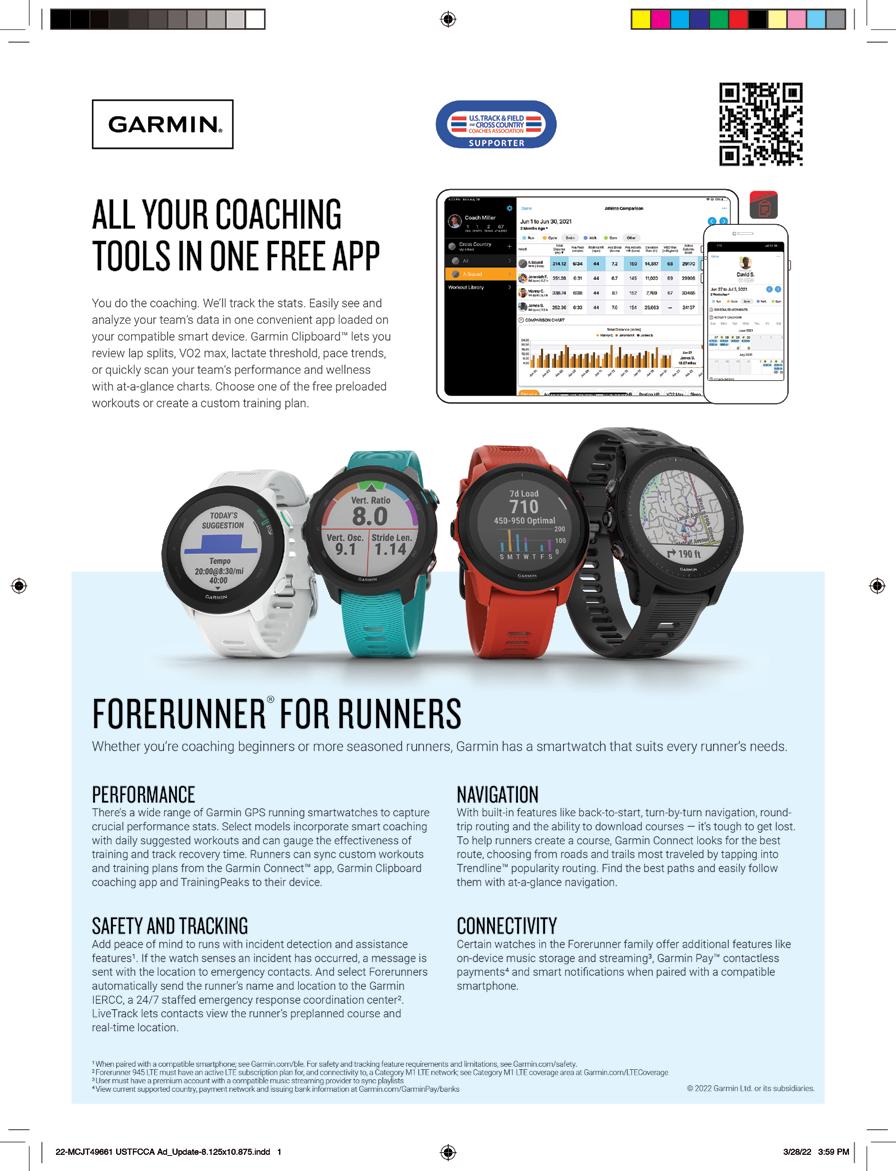
ucsspirit.com
sportsbyapt.com/sport/track directathletics.com




geosurfaces.com


mfathletic.com
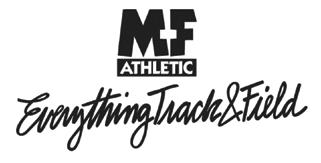
vsathletics.com
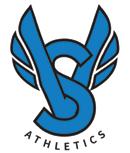
USTFCCCA Supporters mondoworldwide.com simplifaster.com
gillporter.com
ucsspirit.com

42 techniques NOVEMBER 2022
Through their ongoing support of the U.S. Track & Field and Cross Country Coaches Association, these companies demonstrate their strong commitment to the sports of Track & Field and Cross Country. The USTFCCCA strongly encourages each member to purchase products and services from these supporters.







balfour.com connect.marines.com

sportlinesevices.com


getonform.com

NOVEMBER 2022 techniques 43 garmin.com beynonsports.com
coachesdirectory.com maxmedals.com surfaceco.com elliptigo.com lightspeedlift.com
USTFCCCA
Coaches Hall of Fame Class of 2022
JOSH CULBREATH CENTRAL STATE
Josh Culbreath arrived at Central State University in 1988, 32 years after he won bronze in the 400-meter hurdles at the Melbourne Olympic Games. Culbreath envisioned a “nice little track empire” in Wilberforce, Ohio, and that’s exactly what he built. In just eight years on the job, Culbreath led the Marauders to otherworldly heights: ten NAIA track & field team titles (including an unprecedented sweep of the men’s and women’s indoor and outdoor crowns in 1993), eight other runner-up team finishes; and 91 event titles between the two sports. Two years after Josh moved on, his son Jahan continued the Culbreath legacy as Central State’s track & field coach.
GREG KRAFT ARIZONA STATE
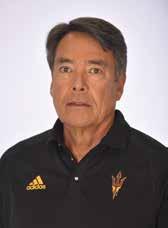
Greg Kraft told his hometown newspaper, at age 19, “I think I’d really enjoy it (coaching) and I think I’d be a pretty good coach.” That was 1974 and nearly 50 years later, Kraft proved right. From the West Coast to the East Coast and everywhere in between, success followed Kraft at every step. Kraft was most prolific at Arizona State, where he led the women’s team to a historic sweep of the NCAA team titles in 2007 and then directed a near-unprecedented men-women sweep of the indoor crowns one year later. The Sun Devils finished top-5 at the NCAA Track & Field Championships 12 times and won 38 event titles under Kraft’s watch, among other feats.
HALSTON TAYLOR MIT
Halston Taylor engineered a Hall-of-Fame career at MIT that spanned nearly 40 years. Taylor’s teams finished top-10 at the NCAA Championships 33 times, won 68 combined New England Women’s and Men’s Athletic Conference (NEWMAC) titles, 44 New England Division III Track & Field Championships and 10 regional crowns in cross country. He led MIT’s women to a pair of Deb Vercauteren NCAA Division III Women’s Program of the Year honors in 2011 and 2015. Taylor’s legacy will be remembered for years to come, as the MIT Department of Athletics, Physical Education and Recreation (DAPER) created an endowment in his name for the position of Director of Cross Country and Track & Field Operations/Head Coach.
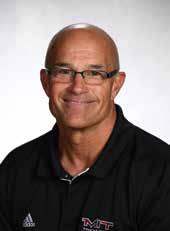
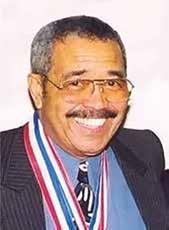
ART VENEGAS LONG BEACH STATE, UCLA
Art Venegas used the knowledge he gained as an All-American thrower at Cal State Northridge to propel himself to a storied coaching career throughout the Golden State. Between stints at his alma mater Long Beach State and finally UCLA, Venegas-coached athletes combined to win 36 NCAA titles, rack up more than 200 All-America honors and numerous all-time marks. Venegas cemented his Hallof-Fame standing in Los Angeles, where his throwers dominated the collegiate ranks. UCLA had a thrower on top of the podium at the NCAA Indoor or Outdoor Championships in all but four years between 1990 and 2002. Many of Venegas’ former athletes are now coaches and continue to build upon his legacy.

44 techniques NOVEMBER 2022
MARK WETMORE COLORADO
Mark Wetmore started coaching because, in his words, it was “offered” to him. Wetmore had a knack for it, as he progressed from overseeing the Mine Mt. Road Department in his hometown of Bernardsville, New Jersey, to now “Running with the Buffaloes” in Boulder, Colorado, aka “The Berkeley of the Rockies.” For nearly three decades, Wetmore has led the CU cross country and track & field programs to unprecedented heights. Since 1995, the Buffs have combined to win eight national titles in 26 trips to the podium in cross country, and capture more than 20 individual titles and earn more than 375 All-America honors between the three sports.
SUE WILLIAMS UC DAVIS

Sue Williams never backed down from a challenge. That’s why, in 1972, Williams took the opportunity to transform the UC Davis women’s cross country team from a club activity to a varsity sport. Three years later, the Aggies had an athlete finish runner-up at the 1975 AIAW Cross Country Championships and it was off to the races. Williams, once named the NCAA Division II Women’s Coach of the Decade, led UCD to unrivaled success. More than ten consecutive trips to the NCAA Championships were prerequisites for her cross country teams - especially her women, who had three top-5 finishes - and athletes won five NCAA event titles and racked up 80 All-America honors between the three sports.
2022 National High School Track & Field Coaches of the Year
TIM BYRNE SALESIANUM SCHOOL (DEL.) BOYS COY


DESMOND DUNHAM ST. JOHN’S COLLEGE HIGH SCHOOL (D.C.) GIRLS COY
Tim Byrne of Salesianum School (Del.) and Desmond Dunham of St. John’s College High School (D.C.) were named the USTFCCCA National Boys and Girls Track & Field Coaches of the Year Presented by the United States Marine Corps.
Byrne and Dunham were chosen by a panel of experts from the original list of state-by-state winners that was released in July. They will be feted at the 2022 USTFCCCA Convention, which will be held December 12-15 at the Gaylord Rockies Resort & Convention Center outside of Denver.
Salesianum School and St. John’s College High School both scored the most points in the history of their respective state’s and district’s championships for their gender, whether it be for the division (the former) or the entire meet (the latter).
At the DIAA State Track & Field Championships, Byrne’s team amassed 170 points – 10 more than the previous DI high. Salesianum School compiled five events titles and scored in 17 events. Salesianum’s 4×200 relay team set a meet record of 1:27.77, and Ryan Banko nearly toppled a 40-year-old DI record in the 3200 (Banko went 9:28.85, record is 9:28.5h).
St. John’s College High School had a resolve-testing regular season schedule. The Cadets sent athletes to the Penn Relays, the Emerging Elite Track & Field Invitational as well as the Gator Track & Field Invitational over the same weekend in April.
The Cadets steamrolled their opponents on the track (and in the field) at Dunbar High School and made waves at the Adidas Outdoor Nationals. The Cadets got an open-event title from Cymia Yourish in the freshman 400 and then snagged 4×400 relay gold in the National Elite division, among other achievements.
This is the first time that coaches from Delaware and D.C. have been named National High School Boys and Girls Track & Field Coaches of the Year.
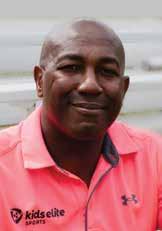
NOVEMBER 2022 techniques 45
The Bowerman Finalists 2022
TREY CUNNINGHAM FLORIDA STATE
Cunningham, who hails from Winfield, Alabama, had a year unlike any other over the hurdles in collegiate history, counting 2019 The Bowerman winner Grant Holloway (in some instances). The Florida State star swept the hurdling titles at the 2022 NCAA Championships with the second-fastest efforts by a collegian ever: 7.38 in the 60H; 13.00 in the 110H. Between the time he debuted at the Clemson Invitational in mid-January to the time he completed the indooroutdoor sweep in Eugene, Oregon, Cunningham posted seven combined alltime top-10 hurdling marks. Cunningham had more 7.42 or faster marks in the 60H than anybody in collegiate history (four) and more 13.22 or faster marks in the 110H than anybody in collegiate history (nine). He is the second finalist for The Bowerman in program history, joining 2011 The Bowerman winner Ngoni Makusha.
AYDEN OWENS-DELERME ARKANSAS
Owens-Delerme, who hails from Pittsburgh, Pennsylvania, became just the fourth athlete in NCAA DI history to sweep the combined event titles at the NCAA Championships, joining 2010 The Bowerman winner Ashton Eaton, Tim Duckworth (2018) and Karel Tilga (2021). The Arkansas standout amassed all-time totals throughout the year – four of them, to be exact. Indoors, Owens-Delerme became the second-best heptathlon performer in collegiate history behind Eaton with his 6272-point total at the Razorback Team Invitational and added another top-10 effort to win the NCAA title in a stirring come-from-behind victory. And speaking of Eaton, Owens-Delerme tied his meet record in the decathlon at the NCAA DI Outdoor Championships with 8457 points. Don’t forget about the former wind-legal collegiate decathlon record of 8528 points at the Mt. SAC Relays that now has him No. 3 in collegiate history.

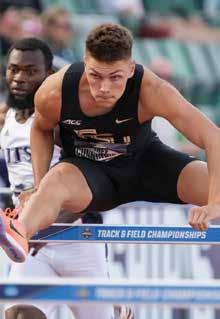
Owens-Delerme is the second finalist in program history alongside 2016 The Bowerman winner Jarrion Lawson.
RANDOLPH ROSS JR. NORTH CAROLINA A&T
Ross, who hails from Garner, North Carolina, went undefeated over 400 meters during the 2022 collegiate season. He polished off that unblemished record with a victory at the NCAA DI Outdoor Championships. Indoors, Ross asserted his dominance in the two-lapper and became the only man in collegiate history with two alltime top-10 marks in the event – in the same season, no less – headlined by his 44.62 scorcher to win the NCAA title. That also made him the third-fastest man in world history behind 2018 The Bowerman winner Michael Norman and Kerron Clement, both of whom clocked their marks as collegians. The North Carolina A&T standout only got faster as the outdoor season progressed, opening with a 45.15 winner at the Tom Jones Memorial and clocking a 44.13 season best in Eugene, Oregon. Ross is the first finalist from an HBCU institution in The Bowerman history.

46 techniques NOVEMBER 2022
ANNA HALL FLORIDA
Hall, who hails from Highland Ranch, Colorado, dominated the combined events like no other in 2022. Indoors, Hall moved to No. 4 all-time in the pentathlon with 4618 points and captured the NCAA title with another near 4600-point effort (4586, to be exact). Outdoors, Hall made the heptathlon look like a walk in the park, putting up three all-time top-10 performances, including her 6458-point total to win the U.S. title and move up to No. 2 behind longtime record-holder Diane Guthrie. Hall closed out her victory at the USATF Combined Event Championships with a jaw-dropping, 2:03.11 800-meter run that was the fastest ever recorded by an American in the seven-eventer (To wit: Hall was ranked No. 20 on the final Descending Order List in the 800 with the mark she ran at the end of a heptathlon). Hall then attempted an unfathomable double at the NCAA DI Outdoor Championships, trying to win both the heptathlon and the 400-meter hurdles. The Florida standout won the heptathlon and finished runner-up in the 400H – which was contested some 24 minutes before the heptathlon’s concluding 800 meters – giving the Gators 18 points, which propelled them to their first outdoor team title in program history. Hall joins Tyra Gittens (2021) and Brianne Theisen (2012) as the only combined event athletes to be named women’s finalists in The Bowerman history.
 CAMRYN ROGERS CALIFORNIA
CAMRYN ROGERS CALIFORNIA
Rogers, who hails from Richmond, British Columbia, took a literal hammer to the collegiate record book – and then some. How good was Rogers in 2022? Try breaking her own collegiate record in the hammer throw three times in the span of two months. Those three performances are among the top-4 in collegiate history, where Rogers’ name is dominant with all of the top-10 performances (eight from this year). Her first raising of the CR this year came in April’s Mt. SAC Relays at 75.73m (248-6), which also equaled the Canadian record. The second improvement of the standard came when only a safe effort was needed at the NCAA West Preliminary Round, but Rogers let it fly for the event’s first collegiate 250-footer at 76.46m (25010). At the NCAA Championships, she held a slim lead after three rounds, as two women collegians surpassed 245-0 (74.68m) for the first time history, but Rogers exploded for a fifth-round 77.67m (254-10) to add four feet to the CR for the event’s largest improvement since 2006 and move her up to No. 9 in world history. It was her third NCAA title in the hammer, tying the most for a woman. Indoors, she competed in the weight throw and moved to =No. 10 collegian all-time at 24.06m (7811¼) in finishing third at the NCAA Indoor Championships. Rogers is the second thrower to be named a women’s finalist in The Bowerman history, joining two-time finalist Maggie Ewen in 2017 and 2018.
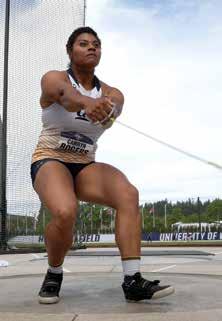 ABBY STEINER KENTUCKY
ABBY STEINER KENTUCKY
Steiner, who hails from Dublin, Ohio, started and finished the year in record fashion. Her first collegiate record took down one of the oldest on the books when she clocked 35.80 in December over 300 meters to break the 40-year-old mark of 35.83 set by Merlene Ottey. Steiner then lowered the 200 CR twice, first to 22.37 and finally to a blistering 22.09 at the SEC Indoor Championships in attaining the American record as well. Then came the NCAA DI Indoor Championships, where she seized the NCAA 200-meter title in a meet-record 22.16 and finished runner-up in the 60 with a PR of 7.10. Outdoors, Steiner seemed to make history in every race. Start with the then-200 outdoor PR of 22.38 in April – sprinted into a 5.6 m/s headwind, no less. At the SEC Outdoor Championships, Steiner contributed the fastest split (48.78) on UK’s record-setting 4×400 relay team (3:21.93) in addition to three runner-up finishes in the 100, 200 and 4×100 relay. Steiner capped her incredible year with a scintillating effort at the NCAA DI Outdoor Championships: a collegiate-record setting 21.80 effort to win the 200, which made her the first woman to own both the indoor and outdoor 200-meter CRs since Ottey; a runner-up finish in the 100, where she PR’d in 10.90; and a blazing third leg on the Wildcats’ 4×400 relay – 48.92, the second-fastest in meet history – that brought them from fourth to first. She joins Keni Harrison (2015) and Sydney McLaughlin (2018) as the only finalists for The Bowerman in program history.

NOVEMBER 2022 techniques 47
ALL PHOTOS BY KIRBY LEE
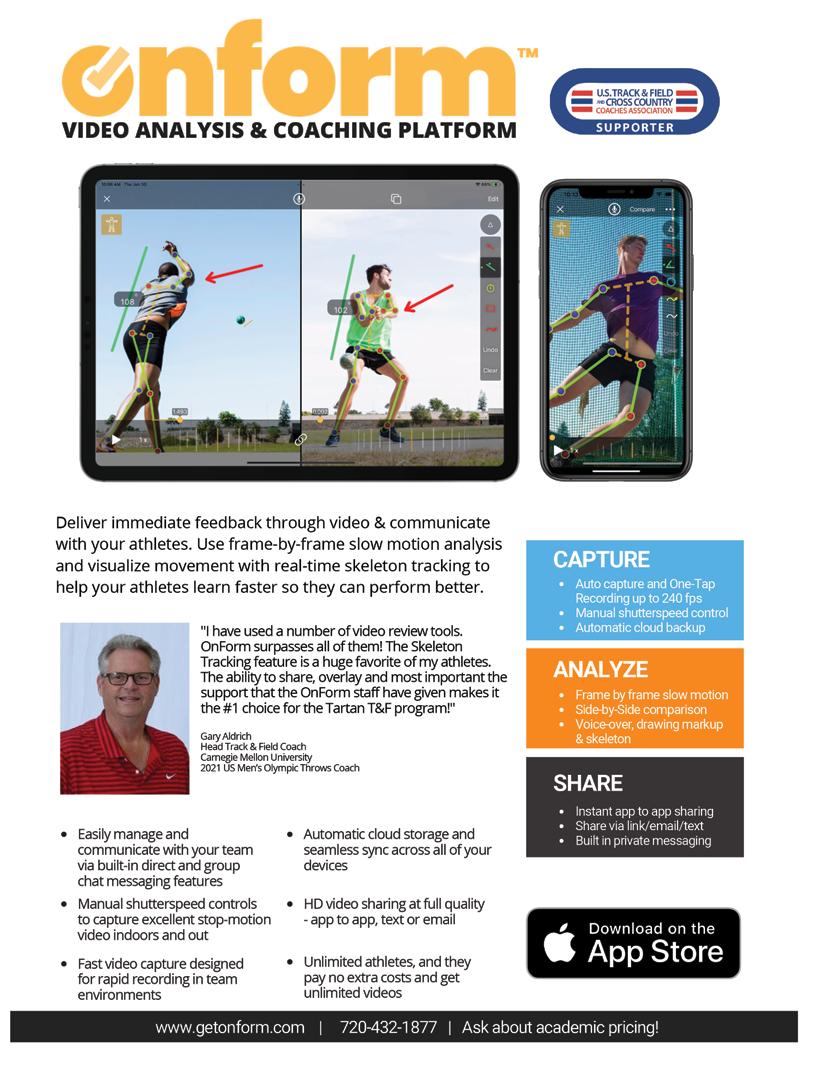
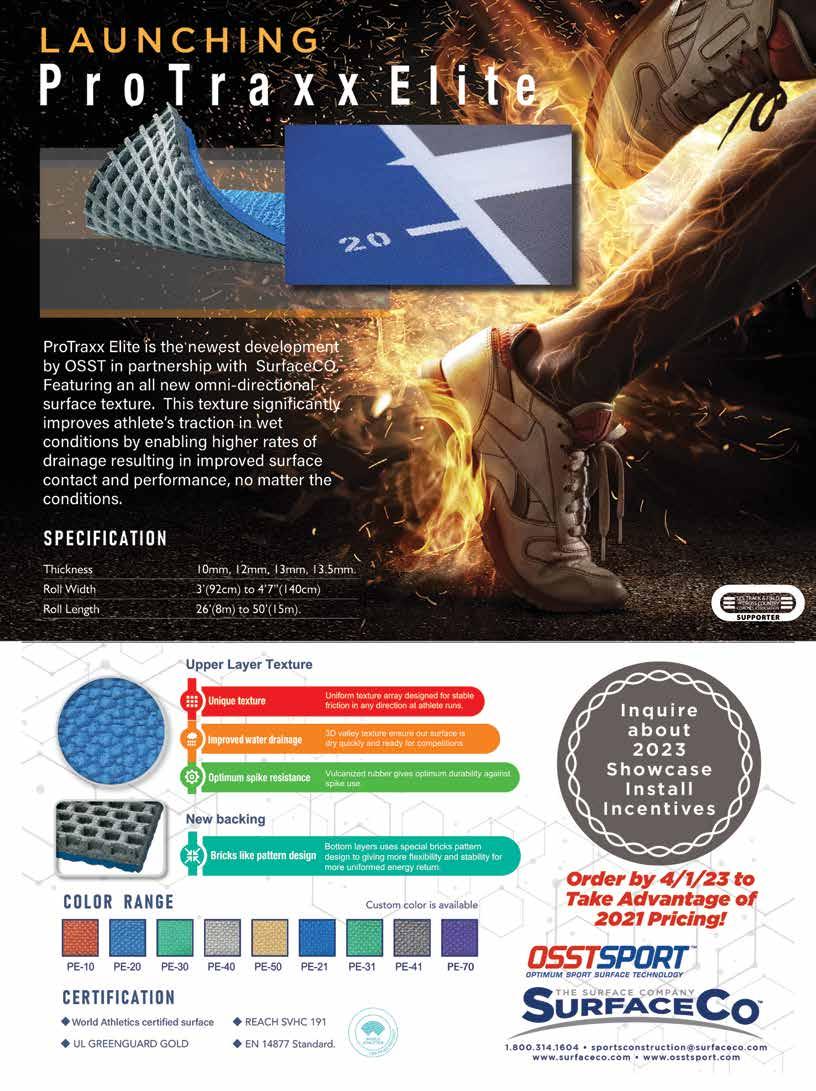





 MIKE
DR. JASON KARP
MIKE
DR. JASON KARP














 KIRBY LEE IMAGE OF SPORT
KIRBY LEE IMAGE OF SPORT































 KIRBY LEE IMAGE
KIRBY LEE IMAGE

































 CAMRYN ROGERS CALIFORNIA
CAMRYN ROGERS CALIFORNIA
 ABBY STEINER KENTUCKY
ABBY STEINER KENTUCKY



